Nature-Inspired Superhydrophobic Coating Materials: Drawing Inspiration from Nature for Enhanced Functionality
Abstract
:1. Introduction

2. Theoretical Background of Wetting
2.1. The Model Drop
2.2. Three-Dimensional Drop on a Chemically Patterned Surface
2.3. Three-Dimensional Suspended Drop on a Topologically Patterned Surface
2.4. Three-Dimensional Collapsed Drop on a Topologically Patterned Surface
3. Fabrication of Superhydrophobic Surfaces
3.1. Top-Down Synthesis
3.1.1. Chemical Etching
3.1.2. Lithography Technique
3.1.3. Template Method
3.1.4. Plasma Treatment
3.2. Bottom-Up Synthesis
3.2.1. Sol–Gel Method
3.2.2. Hydrothermal Technique
3.2.3. Electrospinning
3.2.4. Chemical Vapor Deposition (CVD)
3.2.5. Electrochemical Deposition
3.2.6. Layer-by-Layer Deposition
4. Applications
4.1. Self-Cleaning
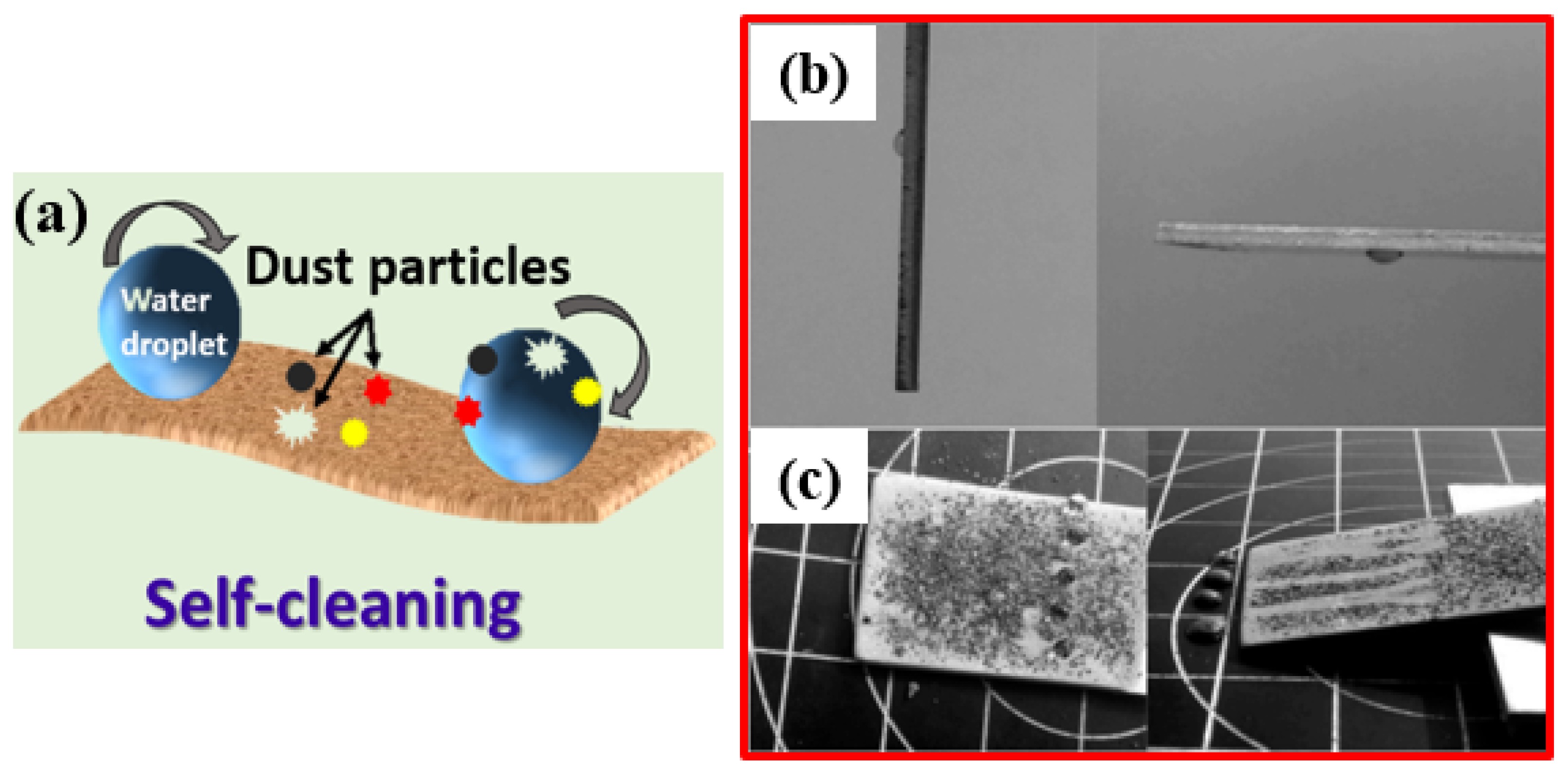
4.2. Anti-Icing
4.3. Anti-Fogging
4.4. Oil–Water Separation
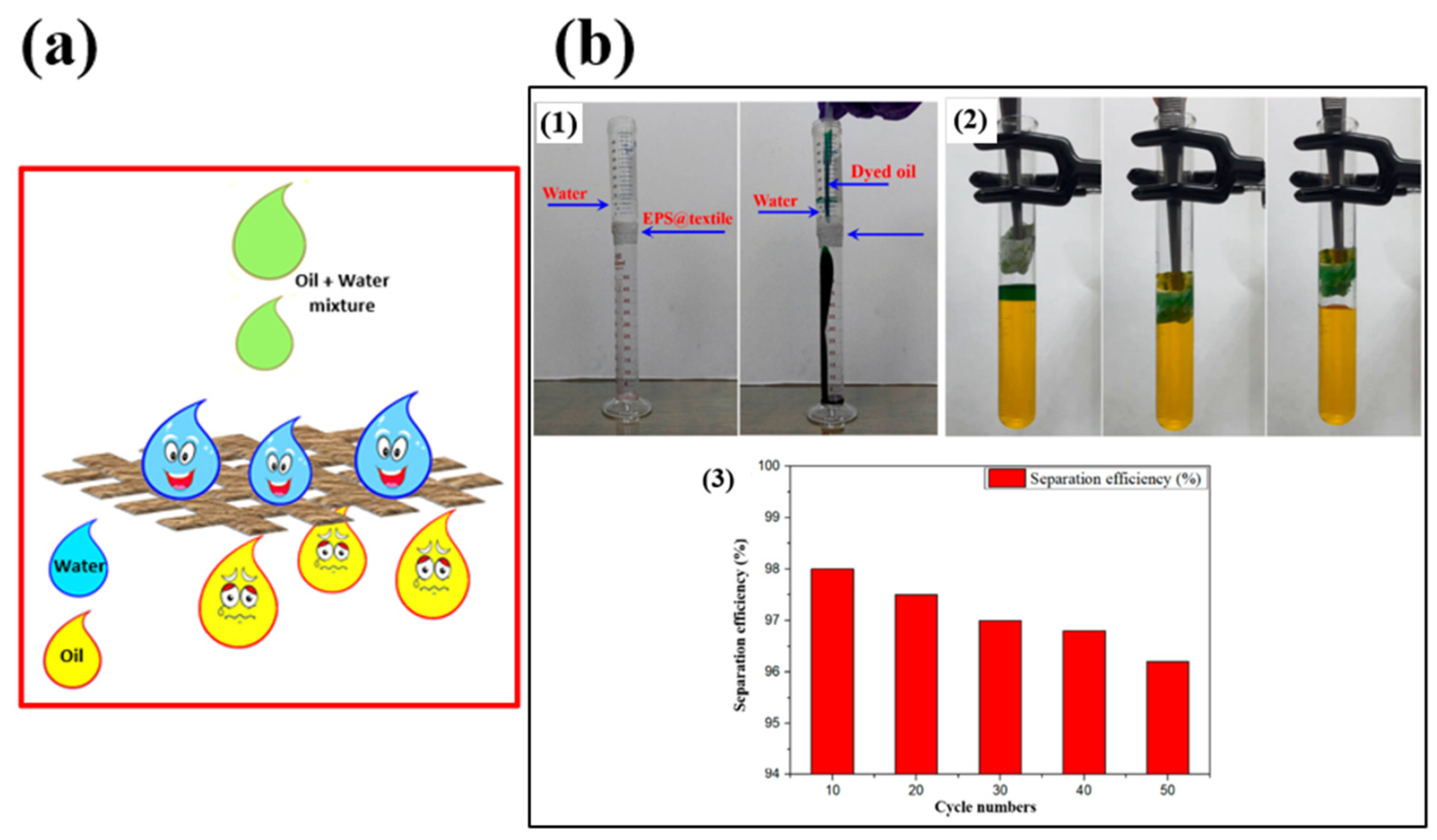
4.5. Anti-Fouling
4.6. Anti-Corrosion
4.7. Anti-Bacterial Property
4.8. Water Harvesting
4.9. Medical Industry
5. Challenges and Constraints in Superhydrophobic Surfaces
5.1. Durability and Stability
5.2. Scalability and Cost-Effectiveness
5.3. Biocompatibility and Health Concerns
5.4. Multifunctional Superhydrophobic Coating/Surfaces
5.5. Environmental Impact
6. Progress in Wetting Research through AI and Machine Learning
7. Practical Implications of the Present Review
- Innovative material design: This review identifies key principles inspired by nature that can guide the development of advanced superhydrophobic nano-coating materials. Researchers and industry professionals can leverage these insights for innovative material design, paving the way for the creation of superior products with enhanced functionalities.
- Functional applications: By drawing inspiration from natural structures, this review proposes practical applications across various domains. These insights could result in the development of coatings customized for specific functions such as self-cleaning, anti-fouling, anti-icing, and more. Implementing nature-inspired coatings with tailored functionalities could significantly impact industries dealing with surface protection and maintenance challenges, ultimately reducing maintenance expenses and prolonging the life of diverse substrates.
- Environmental sustainability: The exploration of environmentally friendly coatings inspired by nature aligns with global efforts for sustainable practices. Understanding the principles of natural structures allows the development of coatings that exhibit superior performance while contributing to eco-friendly coating technologies, reducing the environmental impact of conventional materials.
- Advancements in biomedical coatings: This review highlights the relevance of nature-inspired coatings in biomedical applications, offering potential advancements in medical devices, implants, and drug delivery systems. Coatings designed to interact favorably with biological systems can lead to improved biocompatibility and reduced adverse effects, fostering progress in healthcare technologies.
- Commercialization opportunities: Synthesizing the state-of-the-art in nature-inspired nano-coating materials, this review identifies promising avenues for commercialization and technology transfer. These insights inform the development of marketable products, driving growth in the coatings industry and contributing to economic development.
- In conclusion, the practical implications of this review extend to fostering innovation, tailoring functionalities in coatings, promoting sustainability, advancing biomedical applications, identifying commercialization opportunities, and facilitating interdisciplinary collaboration. The comprehensive insights provided pave the way for real-world applications and transformative advancements in the field of nano-coating materials.
8. Conclusions
Author Contributions
Funding
Data Availability Statement
Conflicts of Interest
References
- Gerasopoulos, K.; Luedeman, W.L.; Ölçeroglu, E.; McCarthy, M.; Benkoski, J.J. Effects of engineered wettability on the efficiency of dew collection. ACS Appl. Mater. Interfaces 2018, 10, 4066–4076. [Google Scholar] [CrossRef]
- Mondal, B.; Eain, M.M.G.; Xu, Q.; Egan, V.M.; Punch, J.; Lyons, A.M. Design and fabrication of a hybrid superhydrophobic–hydrophilic surface that exhibits stable dropwise condensation. ACS Appl. Mater. Interfaces 2015, 7, 23575–23588. [Google Scholar] [CrossRef]
- Camaiti, M.; Brizi, L.; Bortolotti, V.; Papacchini, A.; Salvini, A.; Fantazzini, P. An environmental friendly fluorinated oligoamide for producing nonwetting coatings with high performance on porous surfaces. ACS Appl. Mater. Interfaces 2017, 9, 37279–37288. [Google Scholar] [CrossRef]
- Zhang, X.; Shi, F.; Nia, J.; Jiang, Y.; Wang, Z. Superhydrophobic surfaces: From structural control to functional applications. J. Mater. Chem. 2008, 18, 621–633. [Google Scholar] [CrossRef]
- Roach, P.; Shirtcliff, N.J.; Newton, M.I. Progress in superhydrophobic surface development. Soft Matter 2008, 4, 224–240. [Google Scholar] [CrossRef]
- Lafuma, A.; Quere, D. Superhydrophobic states. Nat. Mater. 2003, 2, 457–460. [Google Scholar] [CrossRef]
- Wenzel, R.N. Resistance of solid surfaces to wetting by water. Ind. Eng. Chem. 1936, 28, 988–994. [Google Scholar] [CrossRef]
- Cassie, A.B.D.; Baxter, S. Wettability of porous surfaces. Trans. Faraday Soc. 1944, 40, 546–551. [Google Scholar] [CrossRef]
- Onda, T.; Shibuichi, S.; Satoh, N.; Tsujii, K. Super-Water-Repellent Fractal Surfaces. Langmuir 1996, 12, 2125–2127. [Google Scholar] [CrossRef]
- Ma, M.; Hill, R.M. Superhydrophobic surfaces. Curr. Opin. Colloid Interface Sci. 2006, 11, 193–202. [Google Scholar] [CrossRef]
- Neinhuis, C.; Barthlott, W. Characterization and distribution of self-cleaning plant surfaces. Ann. Bot. 1997, 79, 667–677. [Google Scholar] [CrossRef]
- Chen, W.; Fadeev, A.Y.; Hsieh, M.C.; Öner, D.; Youngblood, J.; McCarthy, T.J. Ultrahydrophobic and ultralyophobic surfaces: Some comments and examples. Langmuir 1999, 15, 3395–3399. [Google Scholar] [CrossRef]
- Barthlott, W.; Ehler, N. Raster-Elektronenmikroskopie der Epidermis-Oberflächen von Spermatophyten. Trop. Subtrop. Pflanzenwelt 1977, 19, 110. [Google Scholar]
- Bixler, G.D.; Bhushan, B. Rice-and butterfly-wing effect inspired self-cleaning and low drag micro/nanopatterned surfaces in water, oil, and air flow. Nanoscale 2014, 6, 76–96. [Google Scholar] [CrossRef] [PubMed]
- Kumar, M.; Bhardwaj, R. Wetting characteristics of Colocasiaesculenta (Taro) leaf and a bioinspired surface thereof. Sci. Rep. 2020, 10, 935. [Google Scholar] [CrossRef]
- Gao, X.; Yan, X.; Yao, X.; Xu, L.; Zhang, K.; Zhang, J.; Yang, B.; Jiang, L. The dry-style antifogging properties of mosquito compound eyes and artificial analogues prepared by soft lithography. Adv. Mater. 2007, 19, 2213–2217. [Google Scholar] [CrossRef]
- Zheng, Y.; Gao, X.; Jiang, L. Directional adhesion of superhydrophobic butterfly wings. Soft Matter 2007, 3, 178–182. [Google Scholar] [CrossRef]
- Zhu, H.; Huang, Y.; Lou, X.; Xia, F. Beetle-inspired wettable materials: From fabrications to applications. Mater Today Nano 2019, 6, 100034. [Google Scholar] [CrossRef]
- Stark, A.Y.; Subarajan, S.; Jain, D.; Niewiarowski, P.H.; Dhinojwala, A. Superhydrophobicity of the gecko toe pad: Biological optimization versus laboratory maximization. Philos. Trans. Royal Soc. A 2016, 374, 20160184. [Google Scholar] [CrossRef]
- Gao, X.; Jiang, L. Water-repellent legs of water striders. Nature 2004, 432, 36. [Google Scholar] [CrossRef]
- Liu, M.; Wang, S.; Jiang, L. Bioinspired multiscale surfaces with special wettability. MRS Bull. 2013, 38, 375–382. [Google Scholar] [CrossRef]
- Liu, Y.; Wu, M.; Guo, C.; Zhou, D.; Wu, Y.; Wu, Z.; Lu, H.; Zhang, H.; Zhang, Z. A Review on Preparation of Superhydrophobic and Superoleophobic Surface by Laser Micromachining and Its Hybrid Methods. Crystals 2023, 13, 20. [Google Scholar] [CrossRef]
- Guo, Z.; Liu, W. Biomimic from the superhydrophobic plant leaves in nature: Binary structure and unitary structure. Plant Sci. 2007, 172, 1103–1112. [Google Scholar] [CrossRef]
- Barthlott, W.; Neinhuis, C. Purity of the sacred lotus, or escape from contamination in biological surfaces. Planta 1997, 202, 1–8. [Google Scholar] [CrossRef]
- Otten, A.; Herminghaus, S. How plants keep dry: A physicist’s point of view. Langmuir 2004, 20, 2405–2408. [Google Scholar] [CrossRef] [PubMed]
- Liu, Y.; Li, G. A new method for producing “Lotus Effect” on a biomimetic shark skin. J. Colloid Interface Sci. 2012, 388, 235–242. [Google Scholar] [CrossRef] [PubMed]
- Kostal, E.; Stroj, S.; Kasemann, S.; Matylitsky, V.; Domke, M. Fabrication of biomimetic fog-collecting superhydrophilic–superhydrophobic surface micropatterns using femtosecond lasers. Langmuir 2018, 34, 2933–2941. [Google Scholar] [CrossRef] [PubMed]
- Feng, L.; Zhang, Y.; Xi, J.; Zhu, Y.; Wang, N.; Xia, F.; Jiang, L. Petal effect: A superhydrophobic state with high adhesive force. Langmuir 2008, 24, 4114–4119. [Google Scholar] [CrossRef]
- Wang, L.; Guo, X.; Zhang, H.; Liu, Y.; Wang, Y.; Liu, K.; Liang, H.; Ming, W. Recent advances in superhydrophobic and antibacterial coatings for biomedical materials. Coatings 2022, 12, 1469. [Google Scholar] [CrossRef]
- Li, J.; Li, M.; Koh, J.J.; Wang, J.; Lyu, Z. 3D-printed biomimetic structures for energy and environmental applications. DeCarbon 2024, 3, 100026. [Google Scholar] [CrossRef]
- Nomeir, B.; Lakhouil, S.; Boukheir, S.; Ali, M.; Naamane, S. Recent progress on transparent and self-cleaning surfaces by superhydrophobic coatings deposition to optimize the cleaning process of solar panels. Sol. Energy Mater. Sol. Cells 2023, 257, 112347. [Google Scholar] [CrossRef]
- Li, Z.; Liu, P.; Chen, S.; Liu, X.; Yu, Y.; Li, T.; Wan, Y.; Tang, N.; Liu, Y.; Gu, Y. Bioinspired marine antifouling coatings: Antifouling mechanisms, design strategies and application feasibility studies. Eur. Polym. J. 2023, 190, 111997. [Google Scholar] [CrossRef]
- Mishra, S.; Yılmaz-Serçinoğlu, Z.; Moradi, H.; Bhatt, D.; Kuru, C.İ.; Ulucan-Karnak, F. Recent advances in bioinspired sustainable sensing technologies. Nano-Struct. Nano-Objects 2023, 34, 100974. [Google Scholar] [CrossRef]
- George, J.S.; Vijayan, P.P.; Hoang, A.T.; Kalarikkal, N.; Nguyen-Tri, P.; Thomas, S. Recent advances in bio-inspired multifunctional coatings for corrosion protection. Prog. Polym. Sci. 2022, 168, 106858. [Google Scholar] [CrossRef]
- Huang, W.; Huang, J.; Guo, Z.; Liu, W. Icephobic/anti-icing properties of superhydrophobic surfaces. Adv. Colloid Interface Sci. 2022, 304, 102658. [Google Scholar] [CrossRef] [PubMed]
- Naikoo, G.A.; Mustaqeem, M.; Hassan, I.U.; Awan, T.; Arshad, F.; Salim, H.; Qurashi, A. Bioinspired and green synthesis of nanoparticles from plant extracts with antiviral and antimicrobial properties: A critical review. J. Saudi Chem. Soc. 2021, 25, 101304. [Google Scholar] [CrossRef]
- Rasouli, S.; Rezaei, N.; Hamedi, H.; Zendehboudi, S.; Duan, X. Superhydrophobic and superoleophilic membranes for oil-water separation application: A comprehensive review. Mater. Des. 2021, 204, 109599. [Google Scholar] [CrossRef]
- Zhang, F.; Guo, Z. Bioinspired materials for water-harvesting: Focusing on microstructure designs and the improvement of sustainability. Mater. Adv. 2020, 1, 2592–2613. [Google Scholar] [CrossRef]
- Adibnia, V.; Mirbagheri, M.; Faivre, J.; Robert, J.; Lee, J.; Matyjaszewski, K.; Lee, D.W.; Banquy, X. Bioinspired polymers for lubrication and wear resistance. Prog. Polym. Sci. 2020, 110, 101298. [Google Scholar] [CrossRef]
- Gao, L.; McCarthy, T.J. Contact angle hysteresis explained. Langmuir 2006, 22, 6234–6237. [Google Scholar] [CrossRef]
- Deng, Y.; Peng, C.; Dai, M.; Lin, D.; Ali, I.; Alhewairini, S.S.; Zheng, X.; Chen, G.; Li, J.; Naz, I. Recent development of super-wettable materials and their applications in oil-water separation. J. Clean. Prod. 2020, 266, 121624. [Google Scholar] [CrossRef]
- Bell, M.S.; Borhan, A. A Volume-Corrected Wenzel Model. ACS Omega 2020, 5, 8875–8884. [Google Scholar] [CrossRef]
- Quéré, D. Rough ideas on wetting. Phys. A Stat. Mech. Appl. 2002, 313, 32–46. [Google Scholar] [CrossRef]
- Quéré, D. Non-sticking drops. Rep. Prog. Phys. 2005, 68, 2495. [Google Scholar] [CrossRef]
- Öner, D.; McCarthy, T.J. Ultrahydrophobic surfaces. Effects of topography length scales on wettability. Langmuir 2000, 16, 7777–7782. [Google Scholar] [CrossRef]
- Kusumaatmaja, H.; Yeomans, J.M. Modeling contact angle hysteresis on chemically patterned and superhydrophobic surfaces. Langmuir 2007, 23, 6019–6032. [Google Scholar] [CrossRef] [PubMed]
- Schwartz, L.W.; Garoff, S. Contact angle hysteresis on heterogeneous surfaces. Langmuir 1985, 1, 219–230. [Google Scholar] [CrossRef]
- Schwartz, L.W.; Garoff, S. Contact angle hysteresis and the shape of the three-phase line. J. Colloid Interface Sci. 1985, 106, 422–437. [Google Scholar] [CrossRef]
- Oliver, J.F.; Huh, C.; Mason, S.G. Resistance to spreading of liquids by sharp edges. J. Colloid Interface Sci. 1977, 59, 568–581. [Google Scholar] [CrossRef]
- Law, K.Y. Contact Angle Hysteresis on Smooth/Flat and Rough Surfaces. Interpretation, Mechanism, and Origin. Acc. Mater. Res. 2022, 3, 1–7. [Google Scholar] [CrossRef]
- Dorrer, C.; Rühe, J. Advancing and receding motion of droplets on ultrahydrophobic post surfaces. Langmuir 2006, 22, 7652–7657. [Google Scholar] [CrossRef]
- Young, T. An essay on the cohesion of fluids. Philos. Trans. R Soc. Lond. 1805, 95, 65–87. [Google Scholar]
- Wenzel, R.N. Surface roughness and contact angle. J. Phys. Chem. 1949, 53, 1466–1467. [Google Scholar] [CrossRef]
- Milne, A.J.B.; Amirfazli, A. The Cassie equation: How it is meant to be used. Adv. Colloid Interface Sci. 2012, 170, 48–55. [Google Scholar] [CrossRef] [PubMed]
- Briant, A.J.; Wagner, A.J.; Yeomans, J.M. Lattice Boltzmann simulations of contact line motion. I. Liquid-gas systems. Phys. Rev. E 2004, 69, 031602. [Google Scholar] [CrossRef] [PubMed]
- Cahn, J.W. Critical point wetting. J. Chem. Phys. 1977, 66, 3667–3672. [Google Scholar] [CrossRef]
- Dupuis, A.; Yeomans, J.M. Modeling droplets on superhydrophobic surfaces: Equilibrium states and transitions. Langmuir 2005, 21, 2624–2629. [Google Scholar] [CrossRef] [PubMed]
- De Gennes, P.G. Wetting: Statics and dynamics. Rev. Mod. Phys. 1985, 57, 827. [Google Scholar] [CrossRef]
- Joanny, J.F.; De Gennes, P.G. A model for contact angle hysteresis. J. Chem. Phys. 1984, 81, 552–562. [Google Scholar] [CrossRef]
- Kumar, A.; Gogoi, B. Development of durable self-cleaning superhydrophobic coatings for aluminium surfaces via chemical etching method. Tribol. Int. 2018, 122, 114–118. [Google Scholar] [CrossRef]
- Kim, J.H.; Mirzaei, A.; Kim, H.W.; Kim, S.S. Facile fabrication of superhydrophobic surfaces from austenitic stainless steel (AISI 304) by chemical etching. Appl. Surf. Sci. 2018, 439, 598–604. [Google Scholar] [CrossRef]
- Zhu, J.; Duan, Y. Facilely etching of superhydrophobic surface with regular mulriple hierarchical micro-nano structures for crowning wettability. Appl. Surf. Sci. 2024, 648, 159009. [Google Scholar] [CrossRef]
- Rodič, P.; Kapun, B.; Panjan, M.; Milošev, I. Easy and Fast Fabrication of Self-Cleaning and Anti-Icing Perfluoroalkyl Silane Film on Aluminium. Coatings 2020, 10, 234. [Google Scholar] [CrossRef]
- Lo, T.N.H.; Lee, J.; Hwang, H.S.; Park, I. Nanoscale Coatings Derived from Fluoroalkyl and PDMS Alkoxysilanes on Rough Aluminum Surfaces for Improved Durability and Anti-Icing Properties. ACS Appl. Nano Mater. 2021, 4, 7493–7501. [Google Scholar] [CrossRef]
- Wei, D.; Wang, J.; Liu, Y.; Wang, D.; Li, S.; Wang, H. Controllable superhydrophobic surfaces with tunable adhesion on Mg alloys by a simple etching method and its corrosion inhibition performance. Chem. Eng. J. 2021, 404, 126444. [Google Scholar] [CrossRef]
- Shirtcliffe, N.J.; Aqil, S.; Evans, C.; McHale, G.; Newton, M.I.; Perry, C.C.; Roach, P. The use of high aspect ratio photoresist (SU-8) for super-hydrophobic pattern prototyping. J. Micromech. Microeng. 2004, 14, 1384–1389. [Google Scholar] [CrossRef]
- Velasco, J.M.; Vlachopoulou, M.E.; Tserepi, A.; Gogolides, E. Stable superhydrophobic surfaces induced by dual-scale topography on SU-8. Microelectron. Eng. 2010, 87, 782–785. [Google Scholar] [CrossRef]
- Yang, Y.; He, H.; Li, Y.; Qiu, J. Using nanoimprint lithography to create robust, buoyant, superhydrophobic PVB/SiO2 coatings on wood surfaces inspired by red roses petal. Sci. Rep. 2019, 9, 9961. [Google Scholar] [CrossRef] [PubMed]
- Feng, J.; Tuominen, M.T.; Rothstein, J.P. Hierarchical superhydrophobic surfaces fabricated by dual-scale electron-beam lithography with well-ordered secondary nanostructures. Adv. Funct. Mater. 2011, 21, 3715–3722. [Google Scholar] [CrossRef]
- Dev, A.; Choudhury, B.D.; Abedin, A.; Anand, S. Fabrication of periodic nanostructure assemblies by interfacial energy driven colloidal lithography. Adv. Funct. Mater. 2014, 24, 4577–4583. [Google Scholar] [CrossRef]
- Wu, R.; Gilavan, M.T.; Akbar, M.A.; Fan, L.; Selvaganapathy, P.R. Direct transformation of polycarbonate to highly conductive and superhydrophobic graphene/graphitic composite by laser writing and its applications. Carbon 2024, 216, 118597. [Google Scholar] [CrossRef]
- Ghasemlou, M.; Le, P.H.; Daver, F.; Murdoch, B.J.; Ivanova, E.P.; Adhikari, B. Robust and Eco-Friendly Superhydrophobic Starch Nanohybrid Materials with Engineered Lotus Leaf Mimetic Multiscale Hierarchical Structures. ACS Appl. Mater. Interfaces 2021, 13, 36558–36573. [Google Scholar] [CrossRef]
- Guo, C.; Liu, K.; Zhang, T.; Sun, P.; Liang, L. Development of flexible photothermal superhydrophobic microarray by photolithography technology for anti-icing and deicing. Prog. Org. Coat. 2023, 182, 107675. [Google Scholar] [CrossRef]
- Wang, H.; He, M.; Liu, H.; Guan, Y. One-Step Fabrication of Robust Superhydrophobic Steel Surfaces with Mechanical Durability, Thermal Stability, and Anti-icing Function. ACS Appl. Mater. Interfaces 2019, 11, 25586–25594. [Google Scholar] [CrossRef]
- Wang, J.; Zhang, Y.; He, Q. Durable and robust superhydrophobic fluororubber surface fabricated by template method with exceptional thermostability and mechanical stability. Sep. Purif. Technol. 2023, 306, 122423. [Google Scholar] [CrossRef]
- Xu, W.; Yi, P.; Gao, J.; Deng, Y.; Peng, L.; Lai, X. Large-Area Stable Superhydrophobic Poly(dimethylsiloxane) Films Fabricated by Thermal Curing via a Chemically Etched Template. ACS Appl. Mater. Interfaces 2020, 12, 3042–3050. [Google Scholar] [CrossRef] [PubMed]
- Wang, J.; Wu, Y.; Zhang, D.; Li, L.; Wang, T.; Duan, S. Preparation of superhydrophobic flexible tubes with water and blood repellency based on template method. Colloids Surf. A Physicochem. Eng. Asp. 2020, 587, 124331. [Google Scholar] [CrossRef]
- Dai, Z.; Guo, H.; Huang, Q.; Ding, S.; Liu, Y.; Gao, Y.; Zhou, Y.; Sun, G.; Zhou, B. Mechanically robust and superhydrophobic concrete based on sacrificial template approach. Cem. Concr. Compos. 2022, 134, 104796. [Google Scholar] [CrossRef]
- Wu, W.; Guijt, R.M.; Silina, Y.E.; Koch, M.; Manz, A. Plant leaves as templates for soft lithography. RSC Adv. 2016, 6, 22469–22475. [Google Scholar] [CrossRef]
- Zhang, T.; Li, M.; Su, B.; Ye, C.; Li, K.; Shen, W.; Chen, L.; Xue, Z.; Wang, S.; Jiang, L. Bio-inspired anisotropic micro/nano-surface from a natural stamp: Grasshopper wings. Soft Matter 2011, 7, 7973–7975. [Google Scholar] [CrossRef]
- Jafari, R.; Asadollahi, S.; Farzaneh, M. Applications of plasma technology in development of superhydrophobic surfaces. Plasma Chem. Plasma Process. 2013, 33, 177–200. [Google Scholar] [CrossRef]
- Li, M.; Wang, G.C.; Min, H.G. Effect of surface roughness on magnetic properties of Co films on plasma-etched Si(100) substrates. J. Appl. Phys. 1998, 83, 5313–5320. [Google Scholar] [CrossRef]
- Notsu, H.; Yagi, I.; Tatsuma, T.; Tryk, D.A.; Fujishima, A. Introduction of oxygen-containing functional groups onto diamond electrode surfaces by oxygen plasma and anodic polarization. Electrochem. Solid-State Lett. 1999, 2, 522–524. [Google Scholar] [CrossRef]
- Ebert, D.; Bhushan, B. Transparent, superhydrophobic, and wear-resistant surfaces using deep reactive ion etching on PDMS substrates. J. Colloid Interface Sci. 2016, 481, 82–90. [Google Scholar] [CrossRef]
- Nguyen-Tri, P.; Altiparmak, F.; Nguyen, N.; Tuduri, L.; Ouellet-Plamondon, C.M.; Prud’homme, R.E. Robust Superhydrophobic Cotton Fibers Prepared by Simple Dip-Coating Approach Using Chemical and Plasma-Etching Pretreatments. ACS Omega 2019, 4, 7829–7837. [Google Scholar] [CrossRef]
- Somrang, W.; Denchitcharoen, S.; Eiamchai, P.; Horprathum, M.; Chananonnawathorn, C. Superhydrophobic and antireflective surface of nanostructures fabricated by CF4 plasma etching. Mater. Today Proc. 2018, 5, 13879–13885. [Google Scholar] [CrossRef]
- Becker, C.; Petersen, J.; Mertz, G.; Ruch, D.; Dinia, A. High Superhydrophobicity Achieved on Poly(ethylene terephthalate) by Innovative Laser-Assisted Magnetron Sputtering. J. Phys. Chem. C 2011, 115, 10675–10681. [Google Scholar] [CrossRef]
- Airoudj, A.; Gall, F.B.; Roucoules, V. Textile with Durable Janus Wetting Properties Produced by Plasma Polymerization. J. Phys. Chem. C 2016, 120, 29162–29172. [Google Scholar] [CrossRef]
- Molina, R.; Teixidó, J.M.; Kan, C.-W.; Jovančić, P. Hydrophobic Coatings on Cotton Obtained by in Situ Plasma Polymerization of a Fluorinated Monomer in Ethanol Solutions. ACS Appl. Mater. Interfaces 2017, 9, 5513–5521. [Google Scholar] [CrossRef] [PubMed]
- Siddig, E.A.; Zhang, Y.; Yang, B.; Wang, T.; Shi, J.; Guo, Y.; Xu, Y.; Zhang, J. Durable Flame-Resistant and Ultra-Hydrophobic Aramid Fabrics via Plasma-Induced Graft Polymerization. Coatings 2020, 10, 1257. [Google Scholar] [CrossRef]
- Ussenkhan, S.S.; Kyrykbay, B.A.; Yerlanuly, Y.; Zhunisbekov, A.T.; Gabdullin, M.T.; Ramazanov, T.S.; Orazbayev, S.A.; Utegenov, A.U. Fabricating durable and stable superhydrophobic coatings by the atmospheric pressure plasma polymerisation of hexamethyldisiloxane. Heliyon 2024, 10, e23844. [Google Scholar] [CrossRef]
- Latthe, S.S.; Nadargi, D.Y.; Rao, A.V. TMOS based water repellent silica thin films by co-precursor method using TMES as a hydrophobic agent. Appl. Surf. Sci. 2009, 255, 3600–3604. [Google Scholar] [CrossRef]
- Yao, X.; Zhao, W.; Zhang, H.; Zhang, Y.; Zhong, L.; Wu, Y. Performance study of a superhydrophobic nanocellulose membrane on the surface of a wood-based panel prepared via the sol-gel method. Colloid Interface Sci. Commun. 2023, 57, 100758. [Google Scholar] [CrossRef]
- Xiong, J.; Sarkar, D.K.; Chen, X.G. Ultravioletdurable superhydrophobic nanocomposite thin films based on cobalt stearate-coated TiO2 nanoparticles combined with polymethylhydrosiloxane. ACS Omega 2017, 2, 8198–8204. [Google Scholar] [CrossRef] [PubMed]
- Ke, C.; Zhang, C.; Wu, X.; Jiang, Y. Highly transparent and robust superhydrophobic coatings fabricated via a facile sol-gel process. Thin Solid Films 2021, 723, 138583. [Google Scholar] [CrossRef]
- Liang, Z.; Geng, M.; Dong, B.; Zhao, L.; Wang, S. Transparent and robust SiO2/PDMS composite coatings with self-cleaning. Surf. Eng. 2020, 36, 643–650. [Google Scholar] [CrossRef]
- Li, J.; Ding, H.; Zhang, H.; Guo, C.; Hong, X.; Sun, L.; Ding, F. Superhydrophobic Methylated Silica Sol for Effective Oil–Water Separation. Materials 2020, 13, 842. [Google Scholar] [CrossRef]
- Liu, L.; Kong, G.; Zhu, Y.; Che, C. Superhydrophobic graphene aerogel beads for adsorption of oil and organic solvents via a convenient in situ sol-gel method. Colloid Interface Sci. Commun. 2021, 45, 100518. [Google Scholar] [CrossRef]
- Gao, L.; Lu, Y. A robust, anti-acid, and high-temperature–humidity-resistant superhydrophobic surface of wood based on a modified TiO2 film by fluoroalkyl silane. Surf. Coat. Technol. 2015, 262, 33–39. [Google Scholar] [CrossRef]
- Wang, K.; Liu, X. Highly fluorinated and hierarchical HNTs/SiO2 hybrid particles for substrate-independent superamphiphobic coatings. Chem. Eng. J. 2019, 359, 626–640. [Google Scholar] [CrossRef]
- Lu, Q.; Cheng, R. Superhydrophobic wood fabricated by epoxy/Cu2(OH)3Cl NPs/stearic acid with performance of desirable self-cleaning, anti-mold, dimensional stability, mechanical and chemical durability. Colloids Surf. A Physicochem. Eng. Asp. 2022, 647, 129162. [Google Scholar] [CrossRef]
- Yuan, J.; Wang, J.; Zhang, K.; Hu, W. Fabrication and properties of a superhydrophobic film on an electroless plated magnesium alloy. RSC Adv. 2017, 7, 28909–28917. [Google Scholar] [CrossRef]
- Wang, J.; Han, F.; Liang, B.; Geng, G. Hydrothermal fabrication of robustly superhydrophobic cotton fibers for efficient separation of oil/water mixtures and oil-in-water emulsions. J. Ind. Eng. Chem. 2017, 54, 174–183. [Google Scholar] [CrossRef]
- Lan, X.; Zhang, B.; Wang, J.; Fan, X.; Zhang, J. Hydrothermally structured superhydrophobic surface with superior anti-corrosion, anti-bacterial and anti-icing behaviors. Colloids Surf. A Physicochem. Eng. Asp. 2021, 624, 126820. [Google Scholar] [CrossRef]
- Tuong, V.M.; Huyen, N.V.; Kien, N.T.; Dien, N.V. Durable Epoxy@ZnO Coating for Improvement of Hydrophobicity and Color Stability of Wood. Polymers 2019, 11, 1388. [Google Scholar] [CrossRef] [PubMed]
- Wan, Y.; Chen, M.; Liu, W.; Shen, X.; Min, Y.; Xu, Q. The research on preparation of superhydrophobic surfaces of pure copper by hydrothermal method and its corrosion resistance. Electrochim. Acta. 2018, 270, 310–318. [Google Scholar] [CrossRef]
- Kulkarni, A.; Bambole, V.A.; Mahanwar, P.A. Electrospinning of polymers, their modeling and applications. Polym. Plast. Technol. Eng. 2010, 49, 427–441. [Google Scholar] [CrossRef]
- Sas, I.; Gorga, R.E.; Joines, J.A.; Thoney, K.A. Literature Review on Superhydrophobic Self-Cleaning Surfaces Produced by Electrospinning. J. Polym. Sci. B Polym. Phys. 2012, 50, 824–845. [Google Scholar] [CrossRef]
- Si, Y.; Guo, Z. Superhydrophobic nanocoatings: From materials to fabrications and to applications. Nanoscale 2015, 7, 5922–5946. [Google Scholar] [CrossRef]
- Cui, M.; Xu, C.; Shen, Y.; Tian, H.; Feng, H.; Li, J. Electrospinning superhydrophobic nanofibrouspoly(vinylidenefluoride)/stearic acid coatings with excellent corrosion resistance. Thin Solid Film. 2018, 657, 88–94. [Google Scholar] [CrossRef]
- Liu, Z.; Tang, Y.; Zhao, K.; Zhang, Q. Superhydrophobic SiO2 micro/nanofibrous membranes with porous surface prepared by freeze electrospinning for oil adsorption. Colloids Surf. A Physicochem. Eng. Asp. 2019, 568, 356–361. [Google Scholar] [CrossRef]
- Raman, A.; Jayan, J.S.; Deeraj, B.D.S.; Saritha, A.; Joseph, K. Electrospun Nanofibers as Effective Superhydrophobic Surfaces: A Brief review. Surf. Interfaces 2021, 24, 101140. [Google Scholar] [CrossRef]
- Pardo-Figuerez, M.; Lopez-Cordoba, A.; Torres-Giner, S.; Lagaron, J.M. Superhydrophobic bio-coating made by co-continuous electrospinning and electrospraying on polyethylene terephthalate films proposed as easy emptying transparent food packaging. Coatings 2018, 8, 364. [Google Scholar] [CrossRef]
- Ding, B.; Ogawa, T.; Kim, J.; Fujimoto, K.; Shiratori, S. Fabrication of a super-hydrophobic nanofibrous zinc oxide film surface by electrospinning. Thin Solid Films 2008, 516, 2495–2501. [Google Scholar] [CrossRef]
- He, G.; Wan, M.; Wang, Z.; Zhao, Y.; Sun, L. Fabrication of firm, superhydrophobic and antimicrobial PVDF@ZnO@TA@DT electrospun nanofibrous membranes for emulsion separation. Colloids Surf. A Physicochem. Eng. Asp. 2023, 662, 130962. [Google Scholar] [CrossRef]
- Cai, X.; Huang, J.; Lu, X.; Yang, L.; Lin, T.; Lei, T. Facile Preparation of Superhydrophobic Membrane Inspired by Chinese Traditional Hand-Stretched Noodles. Coatings 2021, 11, 228. [Google Scholar] [CrossRef]
- Xiong, J.; Das, S.N.; Shin, B.; Kar, J.P.; Choi, J.H.; Myoung, J.M. Biomimetic hierarchical ZnO structure with superhydrophobic and antireflective properties. J. Colloid Interface Sci. 2010, 350, 344–347. [Google Scholar] [CrossRef] [PubMed]
- Pakdel, A.; Zhi, C.; Bando, Y.; Nakayama, T.; Golberg, D. Boron nitride nanosheet coatings with controllable water repellency. ACS Nano 2011, 5, 6507–6515. [Google Scholar] [CrossRef]
- Rezaei, S.; Manoucheri, I.; Moradian, R.; Pourabbas, B. One-step chemical vapor deposition and modification of silica nanoparticles at the lowest possible temperature and superhydrophobic surface fabrication. Chem. Eng. J. 2014, 252, 11–16. [Google Scholar] [CrossRef]
- Zhang, M.; Zhou, T.; Li, H.; Liu, Q. UV-durable superhydrophobic ZnO/SiO2 nanorod arrays on an aluminum substrate using catalyst-free chemical vapor deposition and their corrosion performance. Appl. Surf. Sci. 2023, 623, 157085. [Google Scholar] [CrossRef]
- Sun, W.; Wang, L.; Yang, Z.; Li, S.; Wu, T.; Liu, G. Fabrication of polydimethylsiloxane-derived superhydrophobic surface on aluminium via chemical vapour deposition technique for corrosion protection. Corros. Sci. 2017, 128, 176–185. [Google Scholar] [CrossRef]
- Cai, Z.; Lin, J.; Hong, X. Transparent superhydrophobic hollow films (TSHFs) with superior thermal stability and moisture resistance. RSC Adv. 2018, 8, 491–498. [Google Scholar] [CrossRef]
- Yang, R.; Liang, Y.; Hong, S.; Zuo, S.; Wu, Y.; Shi, J.; Cai, L.; Li, J.; Mao, H.; Ge, S.; et al. Novel Low-Temperature Chemical Vapor Deposition of Hydrothermal Delignified Wood for Hydrophobic Property. Polymers 2020, 12, 1757. [Google Scholar] [CrossRef]
- Huang, X.; Sun, M.; Shi, X.; Shao, J.; Jin, M.; Liu, W.; Zhang, R.; Huang, S.; Ye, Y. Chemical vapor deposition of transparent superhydrophobic anti-Icing coatings with tailored polymer nanoarray architecture. Chem. Eng. J. 2023, 454, 139981. [Google Scholar] [CrossRef]
- Darband, G.B.; Aliofkhazraei, M.; Khorsand, S.; Sokhanvar, S.; Kaboli, A. Science and engineering of superhydrophobic surfaces: Review of corrosion resistance, chemical and mechanical stability. Arab. J. Chem. 2020, 13, 1763–1802. [Google Scholar] [CrossRef]
- Liu, Q.; Chen, D.; Kang, Z. One-Step Electrodeposition Process To Fabricate Corrosion-Resistant Superhydrophobic Surface on Magnesium Alloy. ACS Appl. Mater. Interfaces 2015, 7, 1859–1867. [Google Scholar] [CrossRef]
- Zhang, B.; Zhao, X.; Li, Y.; Hou, B. Fabrication of durable anticorrosion superhydrophobic surfaces on aluminum substrates via a facile one-step electrodeposition approach. RSC Adv. 2016, 6, 35455–35465. [Google Scholar] [CrossRef]
- Meng, H.; Wang, S.; Xi, J.; Tang, Z.; Jiang, L. Facile means of preparing superamphiphobic surfaces on common engineering metals. J. Phys. Chem. C 2008, 112, 11454–11458. [Google Scholar] [CrossRef]
- Tian, J.; Bao, J.; Li, L.; Sha, J.; Duan, W.; Qiao, M.; Cui, J.; Zhang, Z. Facile fabrication of superhydrophobic coatings with superior corrosion resistance on LA103Z alloy by one-step electrochemical synthesis. Surf. Coat. Technol. 2023, 452, 129090. [Google Scholar] [CrossRef]
- Chen, Z.; Hu, Y.; He, X.; Xu, Y.; Liu, X.; Zhou, Y.; Hao, L.; Ruan, Y. One-step fabrication of soft calcium superhydrophobic surfaces by a simple electrodeposition process. RSC Adv. 2022, 12, 297–308. [Google Scholar] [CrossRef]
- Li, B.; Ouyang, Y.; Haider, Z.; Zhu, Y.; Qiu, R.; Hu, S.; Niu, H.; Zhang, Y.; Chen, M. One-step electrochemical deposition leading to superhydrophobic matrix for inhibiting abiotic and microbiologically influenced corrosion of Cu in seawater environment. Colloids Surf. A Physicochem. Eng. Asp. 2021, 616, 126337. [Google Scholar] [CrossRef]
- Prado, L.H.; Virtanen, S. Cu–MoS2 Superhydrophobic Coating by Composite Electrodeposition. Coatings 2020, 10, 238. [Google Scholar] [CrossRef]
- Richardson, J.J.; Cui, J.; Bjo, M.; Braunger, J.A.; Ejima, H.; Caruso, F. Innovation in layer-by-layer assembly. Chem. Rev. 2016, 116, 14828–14867. [Google Scholar] [CrossRef] [PubMed]
- Li, X.; Du, X.; He, J. Self-cleaning antireflective coatings assembled from peculiar mesoporous silica nanoparticles. Langmuir 2010, 26, 3528–13534. [Google Scholar] [CrossRef]
- Wu, M.; An, N.; Li, Y.; Sun, J. Layer-by-layer assembly of fluorine-free polyelectrolyte–surfactant complexes for the fabrication of self-healing superhydrophobic films. Langmuir 2016, 32, 12361–12369. [Google Scholar] [CrossRef] [PubMed]
- Guo, X.J.; Xue, C.H.; Li, M.; Li, X.; Ma, J.Z. Fabrication of robust, superhydrophobic, electrically conductive and UV-blocking fabrics via layer-by-layer assembly of carbon nanotubes. RSC Adv. 2017, 7, 25560–25565. [Google Scholar] [CrossRef]
- Li, Y.; Liu, F.; Sun, J. A facile layer-by-layer deposition process for the fabrication of highly transparent superhydrophobic coatings. Chem. Commun. 2009, 19, 2730–2732. [Google Scholar] [CrossRef] [PubMed]
- Zheng, L.; Su, X.; Lai, X.; Chen, W.; Li, H.; Zeng, X. Conductive superhydrophobic cotton fabrics via layer-by-layer assembly of carbon nanotubes for oil-water separation and human motion detection. Mater. Lett. 2019, 253, 230–233. [Google Scholar] [CrossRef]
- Shao, C.; Jiang, M.; Zhang, J.; Zhang, Q.; Han, L.; Wu, Y. Construction of a superhydrophobic wood surface coating by layer-by-layer assembly: Self-adhesive properties of polydopamine. Appl. Surf. Sci. 2023, 609, 155259. [Google Scholar] [CrossRef]
- Syed, J.A.; Tang, S.; Meng, X. Super-hydrophobic multilayer coatings with layer number tuned swapping in surface wettability and redox catalytic anti-corrosion application. Sci. Rep. 2017, 7, 4403. [Google Scholar] [CrossRef]
- Strait Research. Available online: https://straitsresearch.com/report/superhydrophobic-coatings-market (accessed on 21 February 2024).
- Liu, K.; Jiang, L. Multifunctional Integration: From Biological to Bio-inspired Materials. ACS Nano 2011, 5, 6786–6790. [Google Scholar] [CrossRef]
- Barthwal, S.; Barthwal, S.; Singh, N.B. Bioinspired Superhydrophobic Nanocomposite Materials: Introduction, Design, and Applications. In Nanocomposites; Jenny Stanford Publishing: Dubai, United Arab Emirates, 2022; pp. 429–481. [Google Scholar]
- Parkin, I.P.; Palgrave, R.G. Self-cleaning Coatings. J. Mater. Chem. 2015, 15, 1689–1695. [Google Scholar] [CrossRef]
- Blossey, R. Self-cleaning Surfaces-virtual Realities. Nat. Mater. 2003, 2, 301–306. [Google Scholar] [CrossRef] [PubMed]
- Liu, K.; Yao, X.; Jiang, L. Recent developments in bio-inspired special wettability. Chem. Soc. Rev. 2010, 39, 3240–3255. [Google Scholar] [CrossRef]
- Nakajima, A. Design of Transparent Hydrophobic Coating. J. Ceram. Soc. Jpn. 2004, 112, 533–540. [Google Scholar] [CrossRef]
- Latthe, S.S.; Sutar, R.S.; Kodag, V.S.; Bhosale, A.K.; Kumar, A.M.; Sadasivuni, K.K.; Xing, R.; Liu, S. Self-cleaning superhydrophobic coatings: Potential industrial applications. Prog. Org. Coat. 2019, 128, 52–58. [Google Scholar] [CrossRef]
- Nguyen-Tri, P.; Tran, H.N.; Plamondon, C.O.; Tuduri, L.; Vo, D.V.N.; Nanda, S.; Mishra, A.; Chao, H.P.; Bajpai, A.K. Recent progress in the preparation, properties and applications of superhydrophobic nano-based coatings and surfaces: A review. Prog. Org. Coat. 2019, 132, 235–256. [Google Scholar] [CrossRef]
- Yu, S.; Guo, Z.; Liu, W. Biomimetic transparent and superhydrophobic coatings: From nature and beyond nature. Chem. Commun. 2015, 51, 1775–1794. [Google Scholar] [CrossRef] [PubMed]
- Lee, H.J.; Michielsen, S.J. Lotus effect: Superhydrophobicity. J. Text. Inst. 2006, 97, 455–462. [Google Scholar] [CrossRef]
- Rossbach, V.; Patanathabutr, P.; Wichitwechkarn, J. Copying and manipulating nature: Innovation for textile materials. Fibers Polym. 2003, 4, 8–14. [Google Scholar] [CrossRef]
- Li, X.M.; Reinhoudt, D.; Crego-Calama, M. What do we need for a superhydrophobic surface? A review on the recent progress in the preparation of superhydrophobic surfaces. Chem. Soc. Rev. 2007, 36, 1350–1368. [Google Scholar] [CrossRef]
- Wang, X.; Ding, H.; Wang, C.; Zhou, R.; Li, Y.; Ao, W. Self-healing superhydrophobic A-SiO2/N-TiO2@ HDTMS coating with self-cleaning property. Appl. Surf. Sci. 2021, 567, 150808. [Google Scholar] [CrossRef]
- Xu, Q.; Wang, X.; Zhang, Y. Green and sustainable fabrication of a durable superhydrophobic cotton fabric with self-cleaning properties. Int. J. Biol. Macromol. 2023, 242, 124731. [Google Scholar] [CrossRef] [PubMed]
- Dong, X.; Meng, J.; Hu, Y.; Wei, X.; Luan, X.; Zhou, H. Fabrication of self-cleaning superhydrophobic surfaces with improved corrosion resistance on 6061 aluminum alloys. Micromachines 2020, 11, 159. [Google Scholar] [CrossRef] [PubMed]
- Shao, W.; Liu, D.; Cao, T.; Cheng, H.; Kuang, J.; Deng, Y.; Xie, W. Study on Favorable Comprehensive Properties of Superhydrophobic Coating Fabricated by Polytetrafluoroethylene Doped with Graphene. Adv. Compos. Hybrid Mater. 2021, 4, 521–533. [Google Scholar] [CrossRef]
- Nodoushan, R.M.; Shekarriz, S.; Shariatinia, Z.; Montazer, M.; Heydari, A. Multifunctional carbonized Zn-MOF coatings for cotton fabric: Unveiling synergistic effects of superhydrophobic, oil-water separation, self-cleaning, and UV protection features. Surf. Coat. Technol. 2023, 25, 130194. [Google Scholar] [CrossRef]
- Wang, K.; Yu, S.; Li, W.; Song, Y.; Gong, P.; Zhang, M.; Li, H.; Sun, D.; Yang, X.; Wang, X. Superhydrophobic and photocatalytic synergistic Self-Cleaning ZnS coating. Appl. Surf. Sci. 2022, 595, 153565. [Google Scholar] [CrossRef]
- Hossain, M.M.; Wu, S.; Nasir, A.; Mohotti, D.; Yuan, Y.; Agyekum-Oduro, E.; Akter, A.; Bhuiyan, K.A.; Ahmed, R.; Nguyen, V.T.; et al. Superhydrophobic and superoleophilic surfaces prepared by one-step plasma polymerization for oil-water separation and self-cleaning function. Surf. Interfaces 2022, 35, 102462. [Google Scholar] [CrossRef]
- Zang, D.; Xun, X.; Gu, Z.; Dong, J.; Pan, T.; Liu, M. Fabrication of superhydrophobic self-cleaning manganese dioxide coatings on Mg alloys inspired by lotus flower. Ceram. Int. 2020, 46, 20328–20334. [Google Scholar] [CrossRef]
- Khairudin, A.; Shaharuddin, A.S.; Hanafi, M.F.; Sapawe, N. Study of self-cleaning superhydrophobic surface based on titanium dioxide nanomaterial. Mater. Today Proc. 2020, 31, A63–A66. [Google Scholar] [CrossRef]
- He, H.; Guo, Z. Superhydrophobic materials used for anti-icing Theory, application, and development. iScience 2021, 24, 103357. [Google Scholar] [CrossRef]
- Kabardin, I.; Dvoynishnikov, S.; Gordienko, M.; Kakaulin, S.; Ledovsky, V.; Gusev, G.; Zuev, V.; Okulov, V. Optical methods for measuring icing of wind turbine blades. Energies 2021, 14, 6485. [Google Scholar] [CrossRef]
- Zheng, H.; Chang, S.; Ma, G.; Wang, S. Anti-icing performance of superhydrophobic surface fabricated by femtosecond laser composited dual-layers coating. Energy Build. 2020, 223, 110175. [Google Scholar] [CrossRef]
- Xiao, X.; Wei, X.; Wei, J.; Wang, J. Multifunctional Fe3O4-based photothermal superhydrophobic composite coating for efficient anti-icing/deicing. Sol. Energy Mater. Sol. Cells 2023, 256, 112313. [Google Scholar] [CrossRef]
- Fan, L.; Xia, M.; Liu, J.; Li, B.; Zhu, T.; Zhao, Y.; Song, L.; Yuan, Y. Fabrication of Superhydrophobic Coatings by Using Spraying and Analysis of Their Anti-Icing Properties. Coatings 2023, 13, 1792. [Google Scholar] [CrossRef]
- Li, X.; Su, H.; Tan, X.; Lin, H.; Wu, Y.; Xiong, X.; Li, Z.; Jiang, L.; Xiao, T.; Chen, W. Photothermal superhydrophobic surface with good corrosion resistance, anti-/de-icing property and mechanical robustness fabricated via multiple-pulse laser ablation. Appl. Surf. Sci. 2023, 646, 158944. [Google Scholar] [CrossRef]
- Barthwal, S.; Lee, B.; Lim, S.H. Fabrication of robust and durable slippery anti-icing coating on textured superhydrophobic aluminum surfaces with infused silicone oil. Appl. Surf. Sci. 2019, 496, 143677. [Google Scholar] [CrossRef]
- Lei, Y.; Jiang, B.; Liu, H.; Zhang, F.; An, Y.; Zhang, Y.; Xu, J.; Li, X.; Liu, T. Mechanically robust superhydrophobic polyurethane coating for anti-icing application. Prog. Org. Coat. 2023, 183, 107795. [Google Scholar] [CrossRef]
- Barthwal, S.; Lim, S.H. Rapid fabrication of a dual-scale micro-nanostructured superhydrophobic aluminum surface with delayed condensation and ice formation properties. Soft Matter 2019, 15, 7945–7955. [Google Scholar] [CrossRef] [PubMed]
- Wang, L.; Teng, C.; Liu, J.; Wang, M.; Liu, G.; Kim, J.Y.; Mei, Q.; Lee, J.K.; Wang, J. Robust anti-icing performance of silicon wafer with hollow micro-/nano-structured ZnO. J. Ind. Eng. Chem. 2018, 62, 46–51. [Google Scholar] [CrossRef]
- Wang, J.; Li, P.; Yu, P. Efficient photothermal deicing employing superhydrophobic plasmonic MXene composites. Adv. Compos. Hybrid Mater. 2022, 5, 3035–3044. [Google Scholar] [CrossRef]
- Lin, H.; Wang, X.; Yu, L.; Chen, Y.; Shi, J. Two-dimensional ultrathin MXene ceramic nanosheets for photothermal conversion. Nano Lett. 2017, 17, 384–391. [Google Scholar] [CrossRef] [PubMed]
- Liu, G.; Zou, J.; Tang, Q.; Yang, X.; Zhang, Y.; Zhang, Q.; Huang, W.; Chen, P.; Shao, J.; Dong, X. Surface modified Ti3C2 MXene nanosheets for tumor targeting photothermal/photodynamic/chemo synergistic therapy. ACS Appl. Mater. Inter. 2017, 9, 40077–40086. [Google Scholar] [CrossRef]
- Wu, H.; Sun, H.; Han, F.; Xie, P.; Zhong, Y.; Quan, B.; Zhao, Y.; Liu, C.; Fan, R.; Guo, Z. Negative permittivity behavior in flexible carbon nanofibers-polydimethylsiloxane films. Eng. Sci. 2021, 17, 113–120. [Google Scholar] [CrossRef]
- Chaudhuri, K.; Alhabeb, M.; Wang, Z.; Shalaev, V.M.; Gogotsi, Y.; Boltasseva, A. Highly broadband absorber using plasmonic titanium carbide (MXene). ACS Photonics 2018, 5, 1115–1122. [Google Scholar] [CrossRef]
- Li, R.; Zhang, L.; Shi, L.; Wang, P. MXene Ti3C2: An effective 2D light-to-heat conversion material. ACS Nano 2017, 11, 3752–3759. [Google Scholar] [CrossRef]
- Herbots, N.; Watson, C.F.; Culbertson, E.J.; Acharya, A.J.; Thilmany, P.R.; Marsh, S.; Marsh, R.T.; Martins, I.P.; Watson, G.P.; Mascareno, A.M.; et al. Super-Hydrophilic, Bio-compatible Anti-Fog Coating for Lenses in Closed Body Cavity Surgery: VitreOxTM–Scientific Model, In Vitro Experiments and In Vivo Animal Trials. MRS Adv. 2016, 1, 2141–2146. [Google Scholar] [CrossRef]
- Durán, I.R.; Laroche, G. Water drop-surface interactions as the basis for the design of anti-fogging surfaces: Theory, practice, and applications trends. Adv. Colloid Interface Sci. 2019, 263, 68–94. [Google Scholar] [CrossRef]
- Wahab, I.F.; Razak, B.A.; Teck, S.W.; Azmi, T.T.; Ibrahim, M.Z.; Lee, J.W. Fundamentals of antifogging strategies, coating techniques and properties of Inorganic materials; a comprehensive review. J. Mater. Res. Technol. 2023, 23, 687–714. [Google Scholar] [CrossRef]
- Huang, L.; Wang, T.; Li, X.; Wang, X.; Zhang, W.; Yang, Y.; Tang, Y. UV-to-IR highly transparent ultrathin diamond nanofilms with intriguing performances: Anti-fogging, self-cleaning and self-lubricating. Appl. Surf. Sci. 2020, 527, 146733. [Google Scholar] [CrossRef]
- Varshney, P.; Mohapatra, S.S. Durable and regenerable superhydrophobic coatings for brass surfaces with excellent self-cleaning and anti-fogging properties prepared by immersion technique. Tribol. Int. 2018, 123, 17–25. [Google Scholar] [CrossRef]
- Li, W.; Chen, Y.; Jiao, Z. Efficient Anti-Fog and Anti-Reflection Functions of the Bio-Inspired, Hierarchically-Architectured Surfaces of Multiscale Columnar Structures. Nanomaterials 2023, 13, 1570. [Google Scholar] [CrossRef] [PubMed]
- Yu, L.; Han, M.; He, F. A review of treating oily wastewater. Arab. J. Chem. 2017, 10, S1913–S1922. [Google Scholar] [CrossRef]
- Medeiros, A.D.L.M.D.; Junior, C.J.G.D.S.; Amorim, J.D.P.D.; Durval, I.J.B.; Costa, A.F.D.S.; Sarubbo, L.A. Oily wastewater treatment: Methods, challenges, and trends. Processes 2022, 10, 743. [Google Scholar] [CrossRef]
- Croce, D.; Pereyra, E. Study of oil/water flow and emulsion formation in electrical submersible pumps. SPE Prod. Oper. 2020, 35, 026–036. [Google Scholar] [CrossRef]
- Hansen, B.H.; Salaberria, I.; Read, K.E.; Wold, P.A.; Hammer, K.M.; Olsen, A.J.; Altin, D.; Øverjordet, I.B.; Nordtug, T.; Bardal, T.; et al. Developmental effects in fish embryos exposed to oil dispersions–The impact of crude oil micro-droplets. Mar. Environ. Res. 2019, 150, 104753. [Google Scholar] [CrossRef] [PubMed]
- Rabbani, Y.; Shariaty-Niassar, M.; Ebrahimi, S.S. The effect of superhydrophobicity of prickly shape carbonyl iron particles on the oil-water adsorption. Ceram. Int. 2021, 47, 28400–28410. [Google Scholar] [CrossRef]
- Bai, L.; Greca, L.G.; Xiang, W.; Lehtonen, J.; Huan, S.; Nugroho, R.W.N.; Tardy, B.L.; Rojas, O.J. Adsorption and assembly of cellulosic and lignin colloids at oil/water interfaces. Langmuir 2018, 35, 571–588. [Google Scholar] [CrossRef]
- Saththasivam, J.; Ogunbiyi, O.; Lawler, J.; Al-Rewaily, R.; Liu, Z. Evaluating dissolved air flotation for oil/water separation using a hybridized coagulant of ferric chloride and chitosan. J. Water Process. Eng. 2022, 47, 102836. [Google Scholar] [CrossRef]
- Lee, J.; Cho, W.C.; Poo, K.M.; Choi, S.; Kim, T.N.; Son, E.B.; Choi, Y.J.; Kim, Y.M.; Chae, K.J. Refractory oil wastewater treatment by dissolved air flotation, electrochemical advanced oxidation process, and magnetic biochar integrated system. J. Water Process. Eng. 2020, 36, 101358. [Google Scholar] [CrossRef]
- Almaraz, N.; Regnery, J.; Vanzin, G.F.; Riley, S.M.; Ahoor, D.C.; Cath, T.Y. Emergence and fate of volatile iodinated organic compounds during biological treatment of oil and gas produced water. Sci. Total Environ. 2020, 699, 134202. [Google Scholar] [CrossRef]
- Benamar, A.; Mahjoubi, F.Z.; Barka, N.; Kzaiber, F.; Boutoial, K.; Ali, G.A.; Oussama, A. Olive mill wastewater treatment using infiltration percolation in column followed by aerobic biological treatment. SN Appl. Sci. 2020, 2, 1–12. [Google Scholar] [CrossRef]
- Kong, D.; He, X.; Khan, F.; Chen, G.; Ping, P.; Yang, H.; Peng, R. Small scale experiment study on burning characteristics for in-situ burning of crude oil on open water. J. Loss Prev. Process Ind. 2019, 60, 46–52. [Google Scholar] [CrossRef]
- Dansawad, P.; Yang, Y.; Li, X.; Shang, X.; Li, Y.; Guo, Z.; Qing, Y.; Zhao, S.; You, S.; Li, W. Smart membranes for oil/water emulsions separation: A review. Adv. Membr. 2022, 2, 100039. [Google Scholar] [CrossRef]
- Cai, Y.; Yu, Y.; Wu, J.; Wang, K.; Dong, Y.; Qu, J.; Hu, J.; Zhang, L.; Fu, Q.; Li, J.; et al. Durable, flexible, and super-hydrophobic wood membrane with nanopore by molecular cross-linking for efficient separation of stabilized water/oil emulsions. EcoMat 2022, 4, e12255. [Google Scholar] [CrossRef]
- Jie, P.; Leilei, Y.; Wenheng, H.; Kun, C. Preparation of Superhydrophobic Copper Mesh for Highly Efficient Oil-Water Separation. Int. J. Electrochem. Sci. 2023, 19, 100417. [Google Scholar] [CrossRef]
- Xu, P.; Li, X. Fabrication of TiO2/SiO2 superhydrophobic coating for efficient oil/water separation. J. Environ. Chem. Eng. 2021, 9, 105538. [Google Scholar] [CrossRef]
- Kao, L.H.; Lin, W.C.; Huang, C.W.; Tsai, P.S. Fabrication of Robust and Effective Oil/Water Separating Superhydrophobic Textile Coatings. Membranes 2023, 13, 401. [Google Scholar] [CrossRef] [PubMed]
- Barthwal, S.; Jeon, Y.; Lim, S.H. Superhydrophobic sponge decorated with hydrophobic MOF-5 nanocoating for efficient oil-water separation and antibacterial applications. Sustain. Mater. Technol. 2022, 33, 00492. [Google Scholar] [CrossRef]
- Barthwal, S.; Lim, S.H. A durable, fluorine-free, and repairable superhydrophobic aluminum surface with hierarchical micro/nanostructures and its application for continuous oil-water separation. J. Membr. Sci. 2021, 618, 118716. [Google Scholar] [CrossRef]
- Barthwal, S.; Barthwal, S.; Singh, B.; Singh, N.B. Multifunctional and fluorine-free superhydrophobic composite coating based on PDMS modified MWCNTs/ZnO with self-cleaning, oil-water separation, and flame retardant properties. Colloids Surf. A Physicochem. Eng. Asp. 2020, 597, 124776. [Google Scholar] [CrossRef]
- Jin, H.; Tian, L.; Bing, W.; Zhao, J.; Ren, L. Bioinspired marine antifouling coatings: Status, prospects, and future. Prog. Mater. Sci. 2022, 124, 100889. [Google Scholar] [CrossRef]
- Yin, X.; Yu, S.; Wang, K.; Cheng, R.; Lv, Z. Fluorine-free preparation of self-healing and anti-fouling superhydrophobic Ni3S2 coating on 304 stainless steel. Chem. Eng. J. 2020, 394, 124925. [Google Scholar] [CrossRef]
- Shi, S.; Meng, S.; Zhao, P.; Xiao, G.; Yuan, Y.; Wang, H.; Liu, T.; Wang, N. Underwater adhesion and curing of superhydrophobic coatings for facile antifouling applications in seawater. Compos. Commun. 2023, 38, 101511. [Google Scholar] [CrossRef]
- Liu, K.; Jiang, L. Metallic surfaces with special wettability. Nanoscale 2011, 3, 825–838. [Google Scholar] [CrossRef] [PubMed]
- Huang, W.F.; Xiao, Y.L.; Huang, Z.J.; Tsui, G.C.; Yeung, K.W.; Tang, C.Y.; Liu, Q. Super-hydrophobic polyaniline-TiO2 hierarchical nanocomposite as anticorrosion coating. Mater. Lett. 2020, 258, 126822. [Google Scholar] [CrossRef]
- Rius-Ayra, O.; Llorca-Isern, N. A robust and anticorrosion non-fluorinated superhydrophobic aluminium surface for microplastic removal. Sci. Total Environ. 2021, 760, 144090. [Google Scholar] [CrossRef]
- Zhang, Z.; Zhao, N.; Qi, F.; Zhang, B.; Liao, B.; Ouyang, X. Reinforced superhydrophobic anti-corrosion epoxy resin coating by fluorine–silicon–carbide composites. Coatings 2020, 10, 1244. [Google Scholar] [CrossRef]
- Barthwal, S.; Lim, S.H. Robust and chemically stable superhydrophobic aluminum-alloy surface with enhanced corrosion-resistance properties. Int. J. Precis. Eng. Manuf.-Green Technol. 2020, 7, 481–492. [Google Scholar] [CrossRef]
- Huang, M.; Lu, G.; Pu, J.; Qiang, Y. Superhydrophobic and smart MgAl-LDH anti-corrosion coating on AZ31 Mg surface. J. Ind. Eng. Chem. 2021, 103, 154–164. [Google Scholar] [CrossRef]
- Xiang, Y.; Tang, W.; Li, H.; Zhang, Y.; Song, R.; Liu, B.; He, Y.; Guo, X.; He, Z. Fabrication of robust Ni-based TiO2 composite@ TTOS superhydrophobic coating for wear resistance and anti-corrosion. Colloids Surf. A Physicochem. Eng. Asp. 2021, 629, 127394. [Google Scholar] [CrossRef]
- Xu, S.; Wang, Q.; Wang, N.; Qu, L.; Song, Q. Study of corrosion property and mechanical strength of eco-friendly fabricated superhydrophobic concrete. J. Clean. Prod. 2021, 323, 129267. [Google Scholar] [CrossRef]
- Wu, M.; Ma, B.; Pan, T.; Chen, S.; Sun, J. Silver-nanoparticle colored cotton fabrics with tunable colors and durable antibacterial and self-healing superhydrophobic properties. Adv. Funct. Mater. 2016, 26, 569–576. [Google Scholar] [CrossRef]
- Ashok, D.; Cheeseman, S.; Wang, Y.; Funnell, B.; Leung, S.F.; Tricoli, A.; Nisbet, D. Superhydrophobic surfaces to combat bacterial surface colonization. Adv. Mater. Interfaces 2023, 10, 2300324. [Google Scholar] [CrossRef]
- Yang, K.; Shi, J.; Wang, L.; Chen, Y.; Liang, C.; Yang, L.; Wang, L. Bacterial anti-adhesion surface design: Surface patterning, roughness and wettability: A review. J. Mater. Sci. Technol. 2022, 99, 82–100. [Google Scholar] [CrossRef]
- Zhang, X.; Wang, L.; Lev, E. Superhydrophobic surfaces for the reduction of bacterial adhesion. RSC Adv 2013, 3, 12003–12020. [Google Scholar] [CrossRef]
- Barthwal, S.; Barthwal, S.; Robust, E.A. Multifunctional Superhydrophobic/Oleophobic Microporous Aluminum Surface via a Two-Step Chemical Etching Process. Surf. Interfaces 2024, 46, 103933. [Google Scholar] [CrossRef]
- Ye, M.; Wang, S.; Ji, X.; Tian, Z.; Dai, L.; Si, C. Nanofibrillated cellulose-based superhydrophobic coating with antimicrobial performance. Adv. Compos. Hybrid Mater. 2023, 6, 30. [Google Scholar] [CrossRef]
- Agbe, H.; Sarkar, D.K.; Chen, X.-G. Tunable superhydrophobic aluminum surfaces with anti-biofouling and antibacterial properties. Coatings 2020, 10, 982. [Google Scholar] [CrossRef]
- Ju, J.; Bai, H.; Zheng, Y.; Zhao, T.; Fang, R.; Jiang, L. A multi-structural and multi-functional integrated fog collection system in cactus. Nat. Commun. 2012, 3, 1247. [Google Scholar] [CrossRef]
- Zheng, Y.; Bai, H.; Huang, Z.; Tian, X.; Nie, F.Q.; Zhao, Y.; Zhai, J.; Jiang, L. Directional water collection on wetted spider silk. Nature 2010, 463, 640–643. [Google Scholar] [CrossRef]
- Chen, H.; Zhang, P.; Zhang, L.; Liu, H.; Jiang, Y.; Zhang, D.; Han, Z.; Jiang, L. Continuous directional water transport on the peristome surface of Nepenthes alata. Nature 2016, 532, 85–89. [Google Scholar] [CrossRef] [PubMed]
- Parker, A.R.; Lawrence, C.R. Water capture by a desert beetle. Nature 2001, 414, 33–34. [Google Scholar] [CrossRef]
- Gao, Y.; Wang, J.; Xia, W.; Mou, X.; Cai, Z. Reusable hydrophilic-superhydrophobic patterned weft backed woven fabric for high-efficiency water-harvesting application. ACS Sustain. Chem. Eng. 2018, 6, 7216–7220. [Google Scholar] [CrossRef]
- Kim, H.; Yang, S.; Rao, S.R.; Narayanan, S.; Kapustin, E.A.; Furukawa, H.; Umans, A.S.; Yaghi, O.M.; Wang, E.N. Water harvesting from air with metal-organic frameworks powered by natural sunlight. Science 2017, 356, 430–434. [Google Scholar] [CrossRef]
- Do, V.; Chun, D. Facile fabrication of extreme-wettability contrast surfaces for efficient water harvesting using hydrophilic and hydrophobic silica nanoparticles. Colloids Surf. A Physicochem. Eng. Asp. 2023, 671, 131664. [Google Scholar] [CrossRef]
- Yu, Z.; Zhang, H.; Huang, J.; Li, S.; Zhang, S.; Cheng, Y.; Mao, J.; Dong, X.; Gao, S.; Wang, S.; et al. Namib desert beetle inspired special patterned fabric with programmable and gradient wettability for efficient fog harvesting. J. Mater. Sci. Technol. 2021, 61, 85–92. [Google Scholar] [CrossRef]
- Bai, H.; Zhao, T.; Wang, X.; Wu, Y.; Li, K.; Yu, C.; Jiang, L.; Cao, M. Cactus kirigami for efficient fog harvesting: Simplifying a 3D cactus into 2D paper art. J. Mater. Chem. A 2020, 8, 13452–13458. [Google Scholar] [CrossRef]
- Zhai, L.; Berg, M.C.; Cebeci, F.C.; Kim, Y.; Milwid, J.M.; Rubner, M.F.; Cohen, R.E. Patterned Superhydrophobic Surfaces: Toward a Synthetic Mimic of the Namib Desert Beetle. Nano Lett. 2006, 6, 1213–1217. [Google Scholar] [CrossRef] [PubMed]
- Park, J.K.; Kim, S. Three-Dimensionally Structured Flexible Fog Harvesting Surfaces Inspired by Namib Desert Beetles. Micromachines 2019, 10, 201. [Google Scholar] [CrossRef] [PubMed]
- Choi, Y.; Baek, K.; So, H. 3D-printing-assisted fabrication of hierarchically structured biomimetic surfaces with dual-wettability for water harvesting. Sci. Rep. 2023, 13, 10691. [Google Scholar] [CrossRef]
- Das, S.; Kumar, S.; Samal, S.K.; Mohanty, S.; Nayak, S.K. A review on superhydrophobic polymer nanocoatings: Recent development and applications. J. Ind. Eng. Chem. 2018, 57, 2727–2745. [Google Scholar] [CrossRef]
- Sun, Z.; Ding, L.; Tong, W.; Ma, C.; Yang, D.; Guan, X.; Xiao, Y.; Xu, K.; Li, Q.; Lv, C. Superhydrophobic blood-repellent tubes for clinical cardiac surgery. Mater. Des. 2023, 232, 112148. [Google Scholar] [CrossRef]
- Cao, D.; Zhang, Y.; Shi, X.; Gong, H.; Feng, D.; Guo, X.; Shi, Z.; Zhu, S.; Cui, Z. Fabrication of superhydrophobic coating for preventing microleakage in a dental composite restoration. Mater. Sci. Eng. C 2017, 78, 333–340. [Google Scholar] [CrossRef] [PubMed]
- Pyzer-Knapp, E.O.; Pitera, J.W.; Staar, P.W.J.; Takeda, S.; Laino, T.; Sanders, D.P.; Sexton, J.; Smith, J.R.; Curioni, A. Accelerating materials discovery using artificial intelligence, high performance computing and robotics. NPJ Comput. Mater. 2022, 8, 84. [Google Scholar] [CrossRef]
- Li, J.; Lim, K.; Yang, H.; Ren, Z.; Raghavan, S.; Chen, P.-O.; Buonassisi, T.; Wang, X. AI Applications through the Whole Life Cycle of Material Discovery. Matter 2020, 3, 393–432. [Google Scholar] [CrossRef]
- Lu, W.; Lee, N.A.; Buehler, M.J. Modeling and design of heterogeneous hierarchical bioinspired spider web structures using deep learning and additive manufacturing. Proc. Natl. Acad. Sci. USA 2023, 120, e2305273120. [Google Scholar] [CrossRef] [PubMed]
- Studart, A.R. Biologically Inspired Dynamic Material Systems. Angew. Chem. Int. Ed. 2015, 54, 3400–3416. [Google Scholar] [CrossRef] [PubMed]
- Sun, J.; Bhushan, B. Nanomanufacturing of bioinspired surfaces. Tribol. Int. 2019, 129, 67–74. [Google Scholar] [CrossRef]
- Li, Y.; Zhang, Q.; Zhang, J.; Jin, L.; Zhao, X.; Xu, T. A top-down approach for fabricating free-standing bio-carbon supercapacitor electrodes with a hierarchical structure. Sci. Rep. 2015, 5, 14155. [Google Scholar] [CrossRef]
- Aziz, M.S. Biomimicry as an approach for bio-inspired structure with the aid of computation. Alex. Eng. J. 2016, 55, 707–714. [Google Scholar] [CrossRef]
- Bonfanti, S.; Guerra, R.; Zaiser, M.; Zapperi, S. Digital strategies for structured and architected materials design. APL Mater. 2021, 9, 020904. [Google Scholar] [CrossRef]
- Yu, C.H.; Tseng, B.Y.; Yang, Z.; Tung, C.C.; Zhao, E.; Ren, Z.F.; Yu, S.S.; Chen, P.Y.; Chen, C.S.; Buehler, M.J. Hierarchical multiresolution design of bioinspired structural composites using progressive reinforcement learning. Adv. Theory Simul. 2022, 5, 2200459. [Google Scholar] [CrossRef]
- Lantada, A.D.; Franco-Martínez, F.; Hengsbach, S.; Rupp, F.; Thelen, R.; Bade, K. Artificial intelligence aided design of microtextured surfaces: Application to controlling wettability. Nanomaterials 2020, 10, 2287. [Google Scholar] [CrossRef] [PubMed]
- Gu, G.X.; Chen, C.-T.; Richmond, D.J.; Buehler, M.J. Bioinspired hierarchical composite design using machine learning: Simulation, additive manufacturing, and experiment. Mater. Horiz. 2018, 5, 939–945. [Google Scholar] [CrossRef]
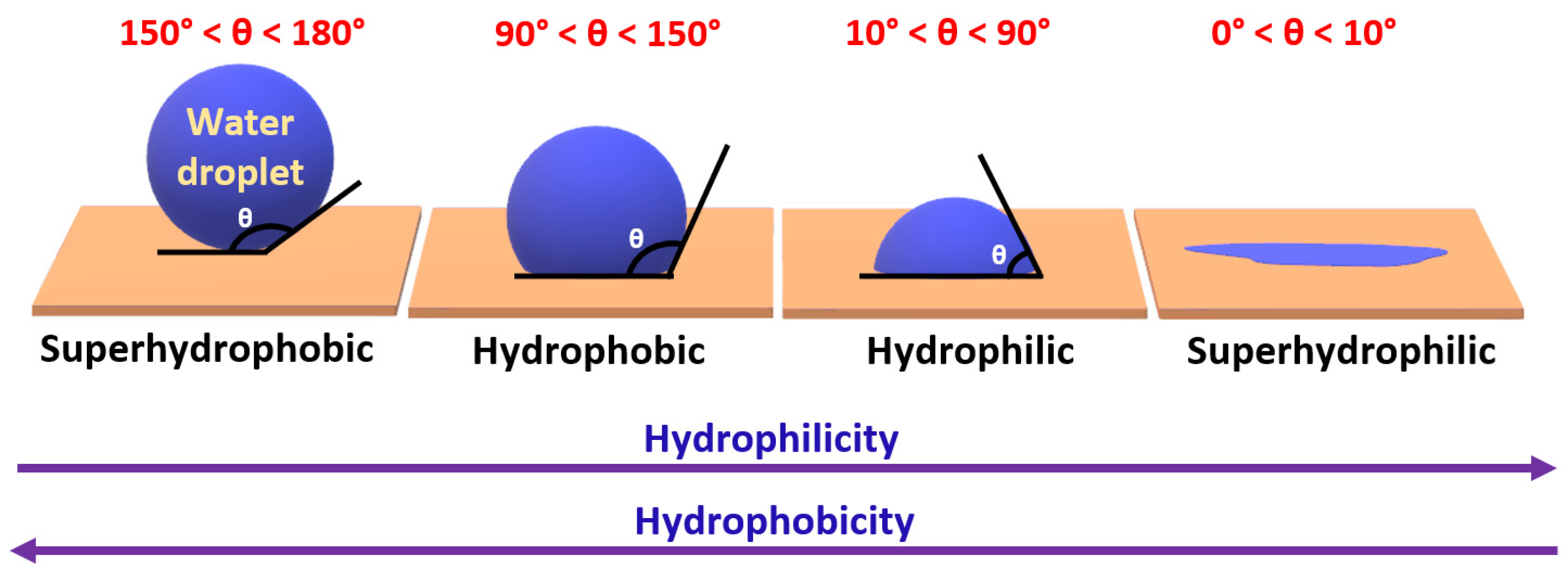
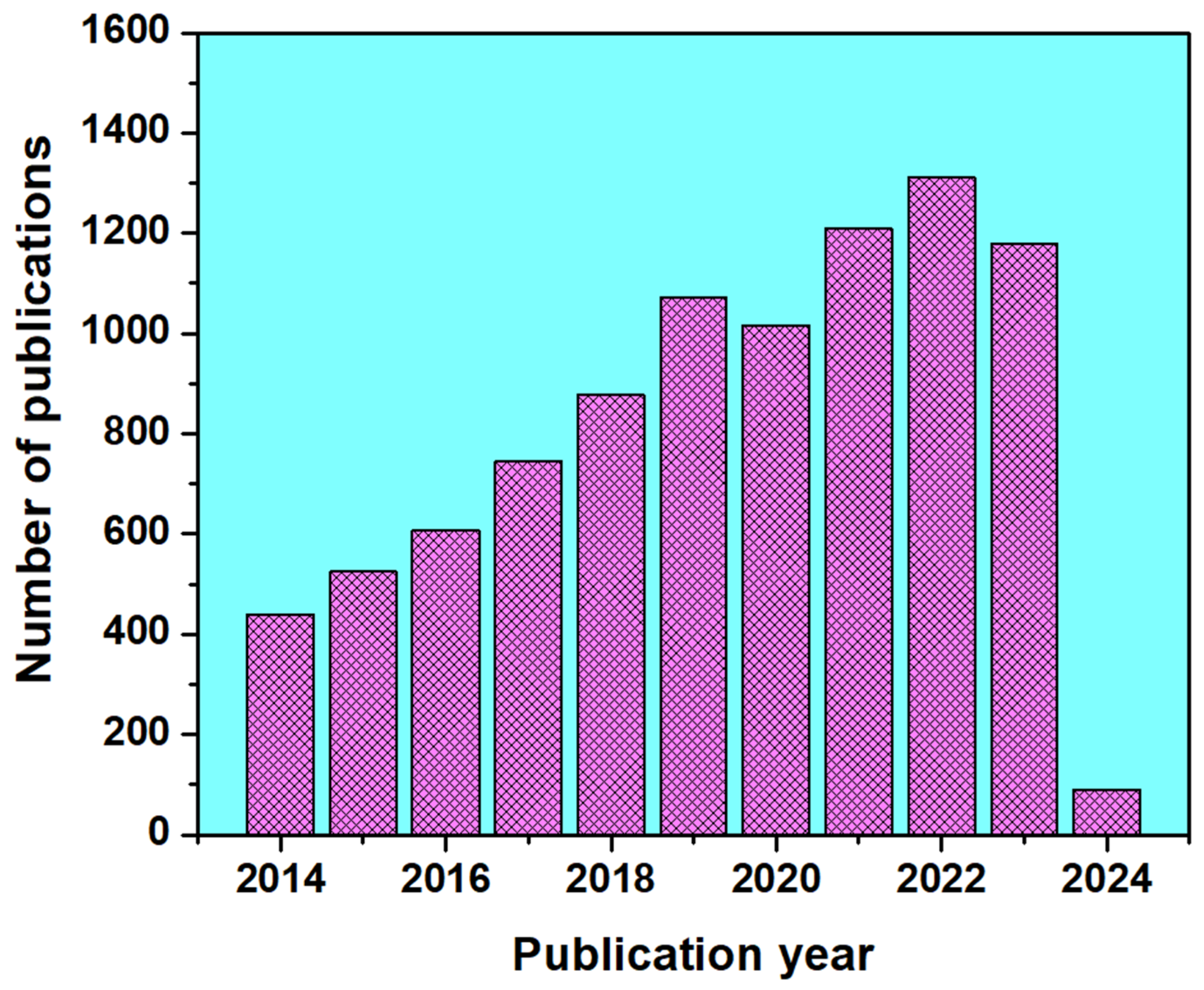

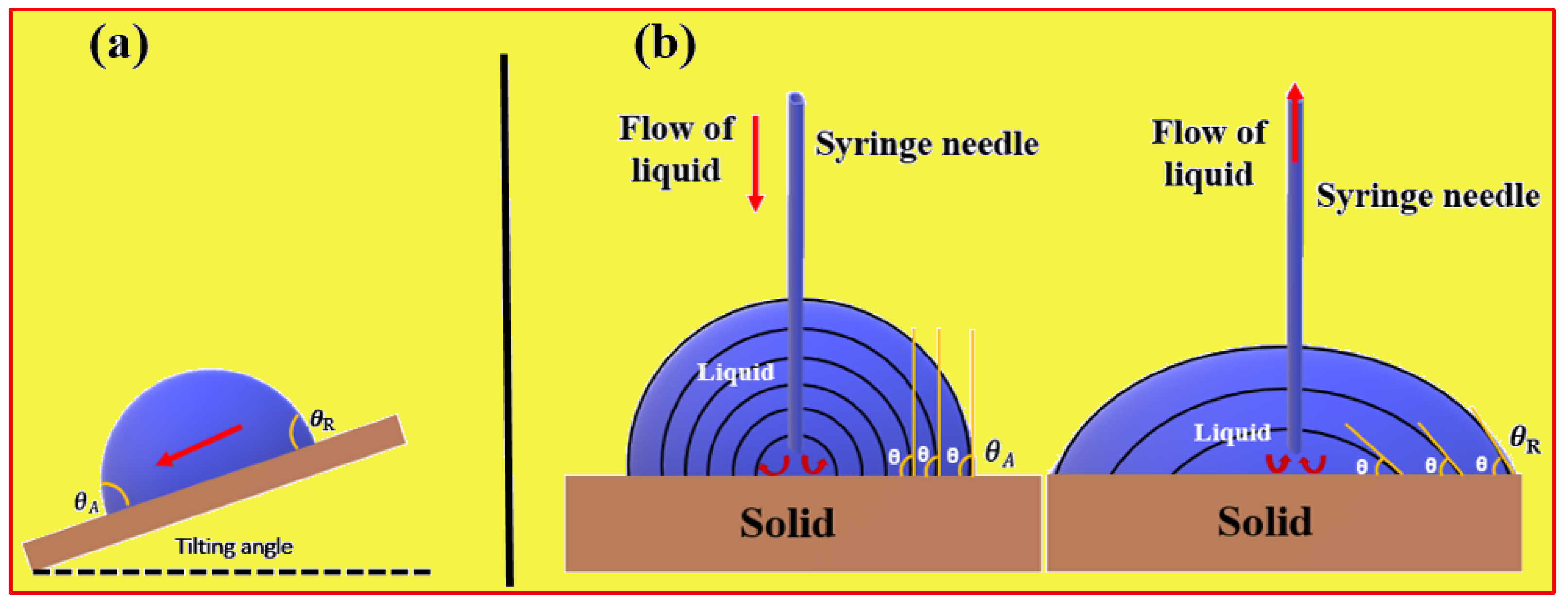

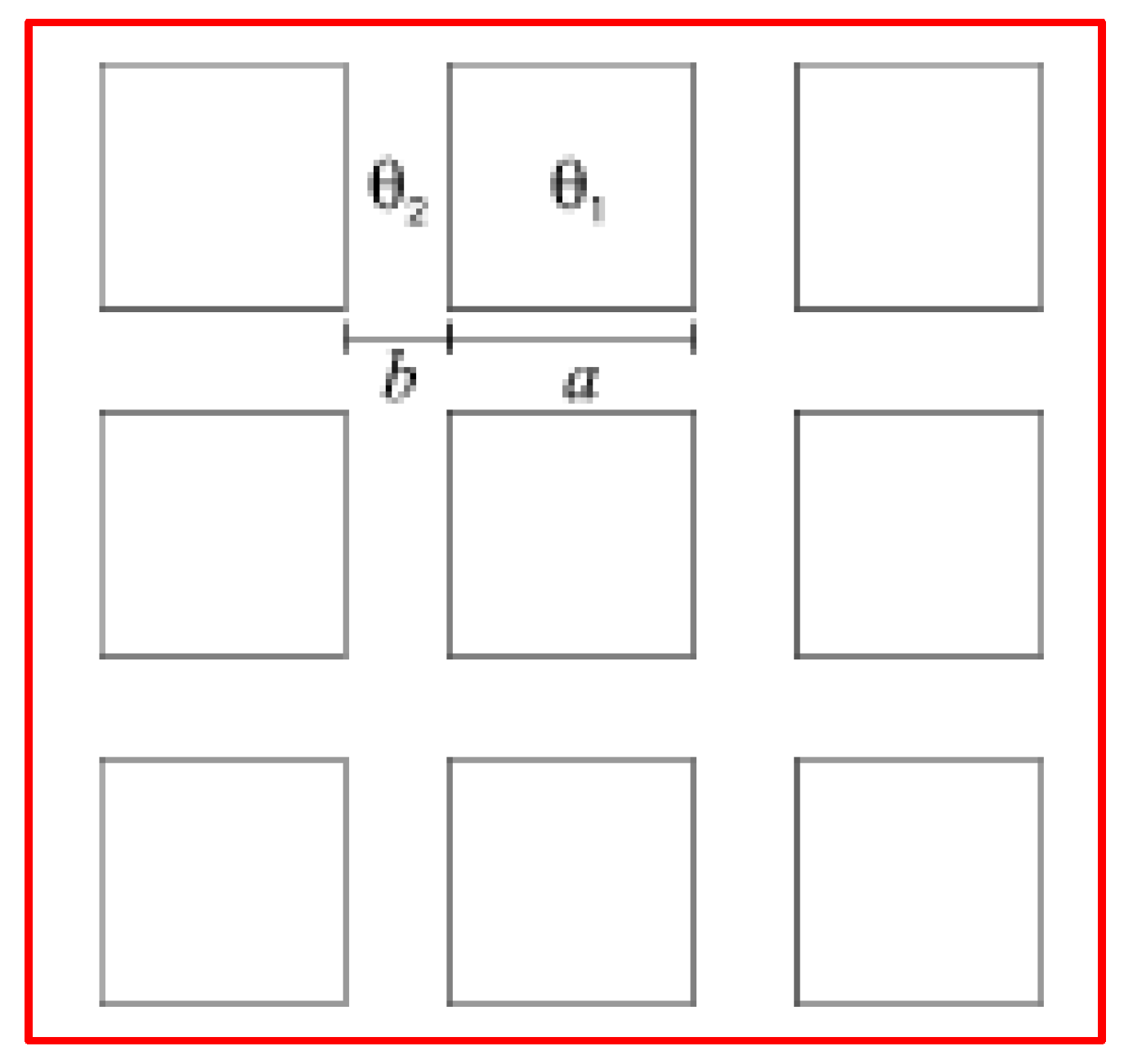
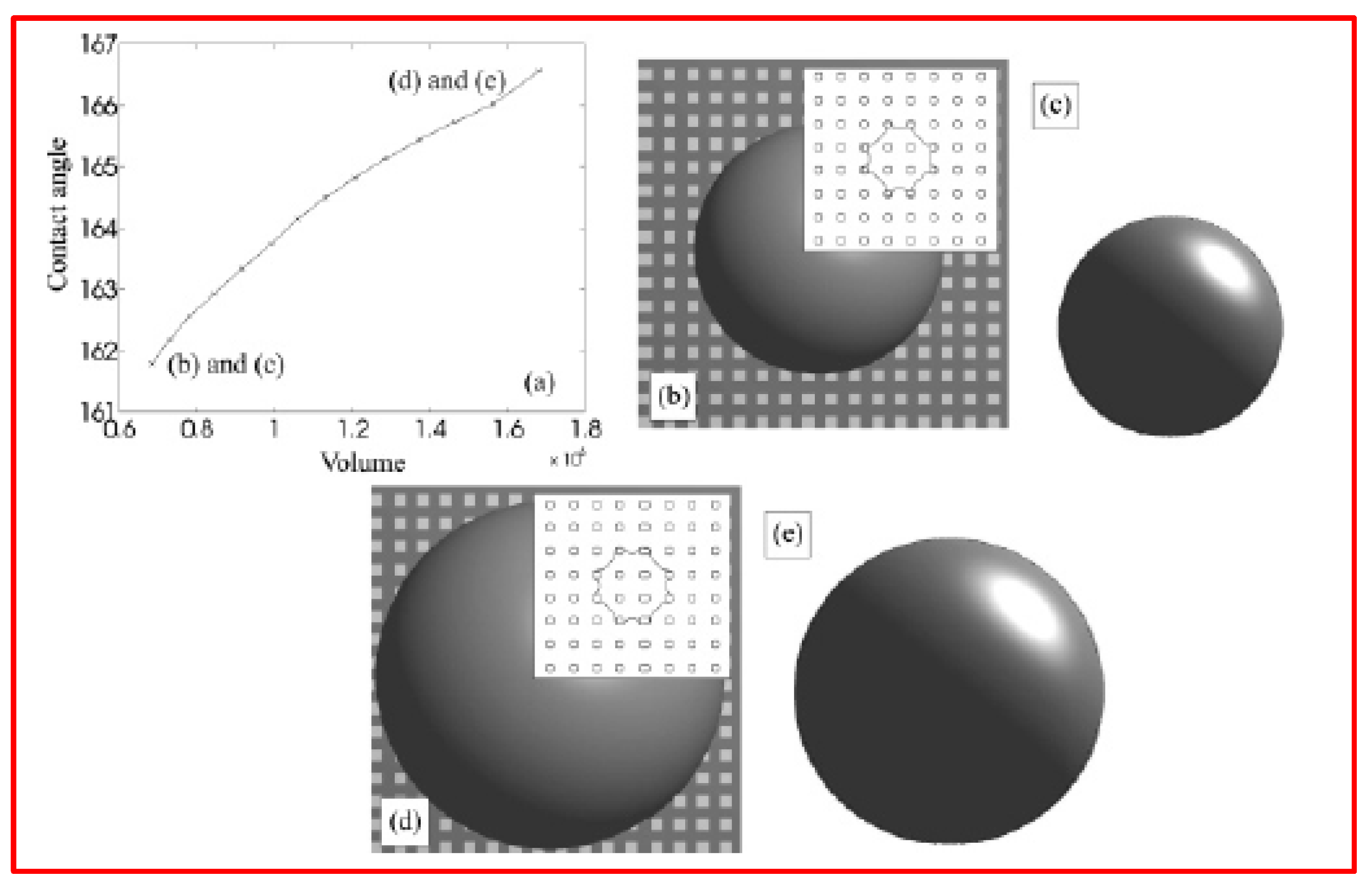


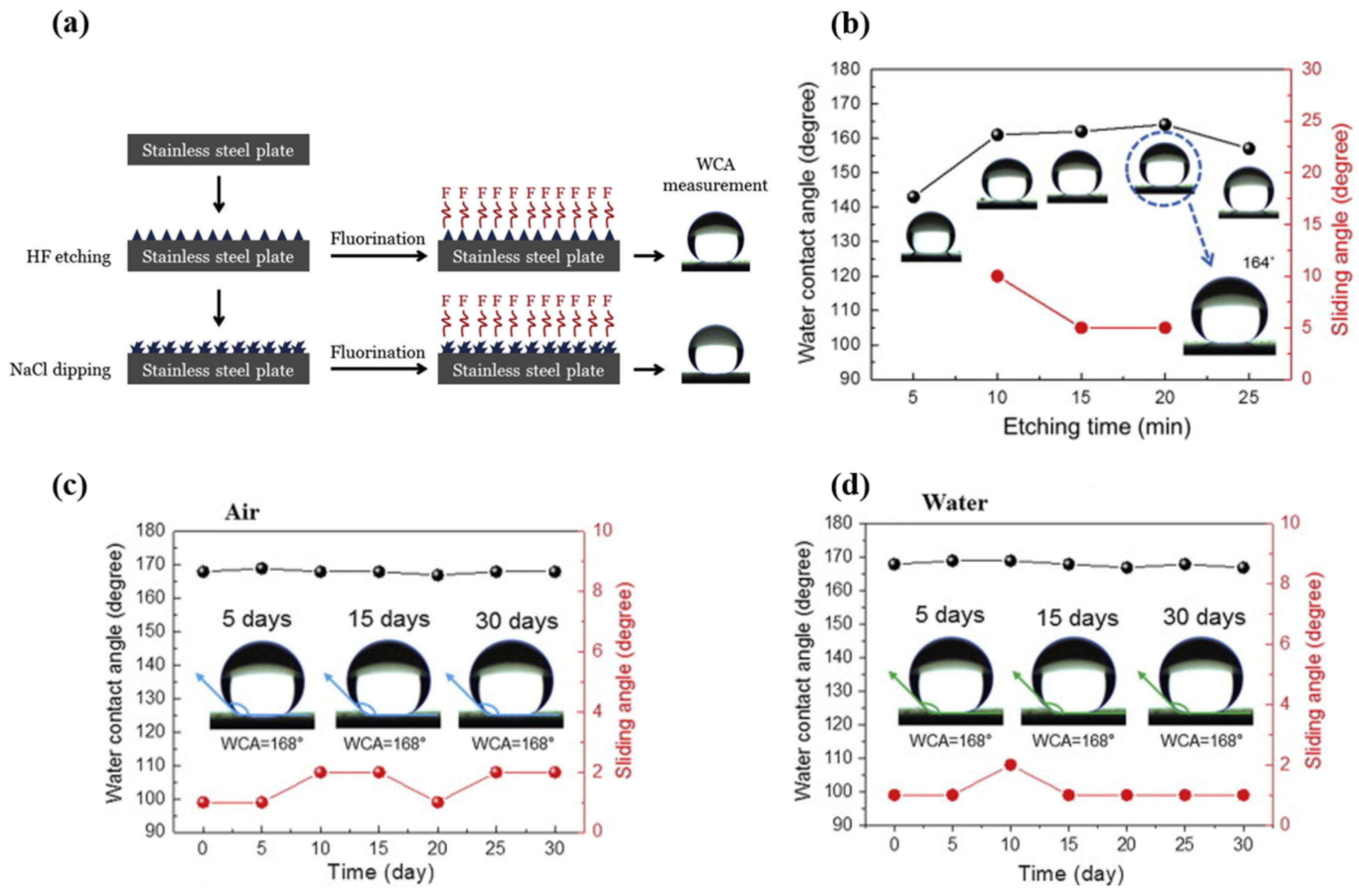
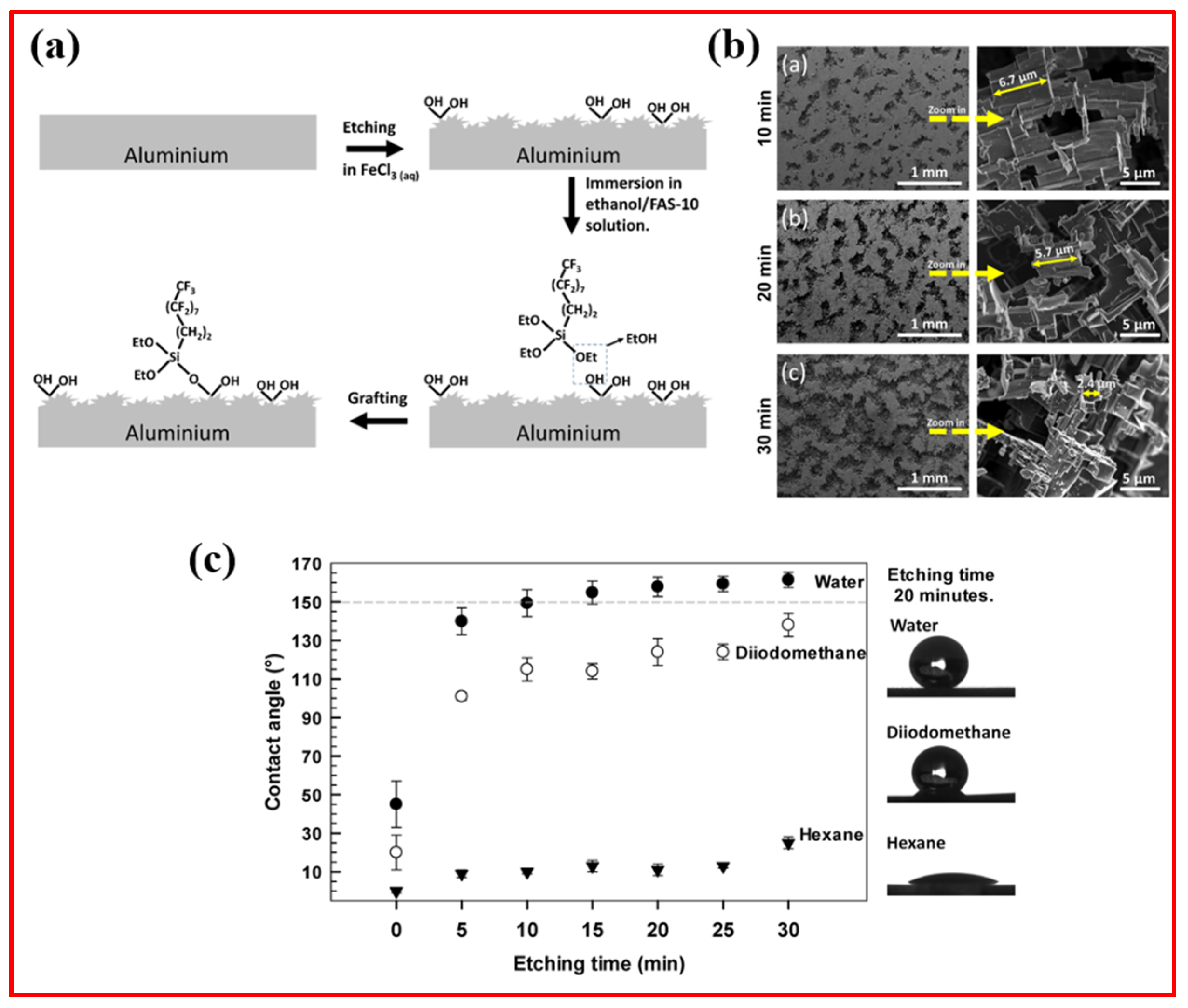
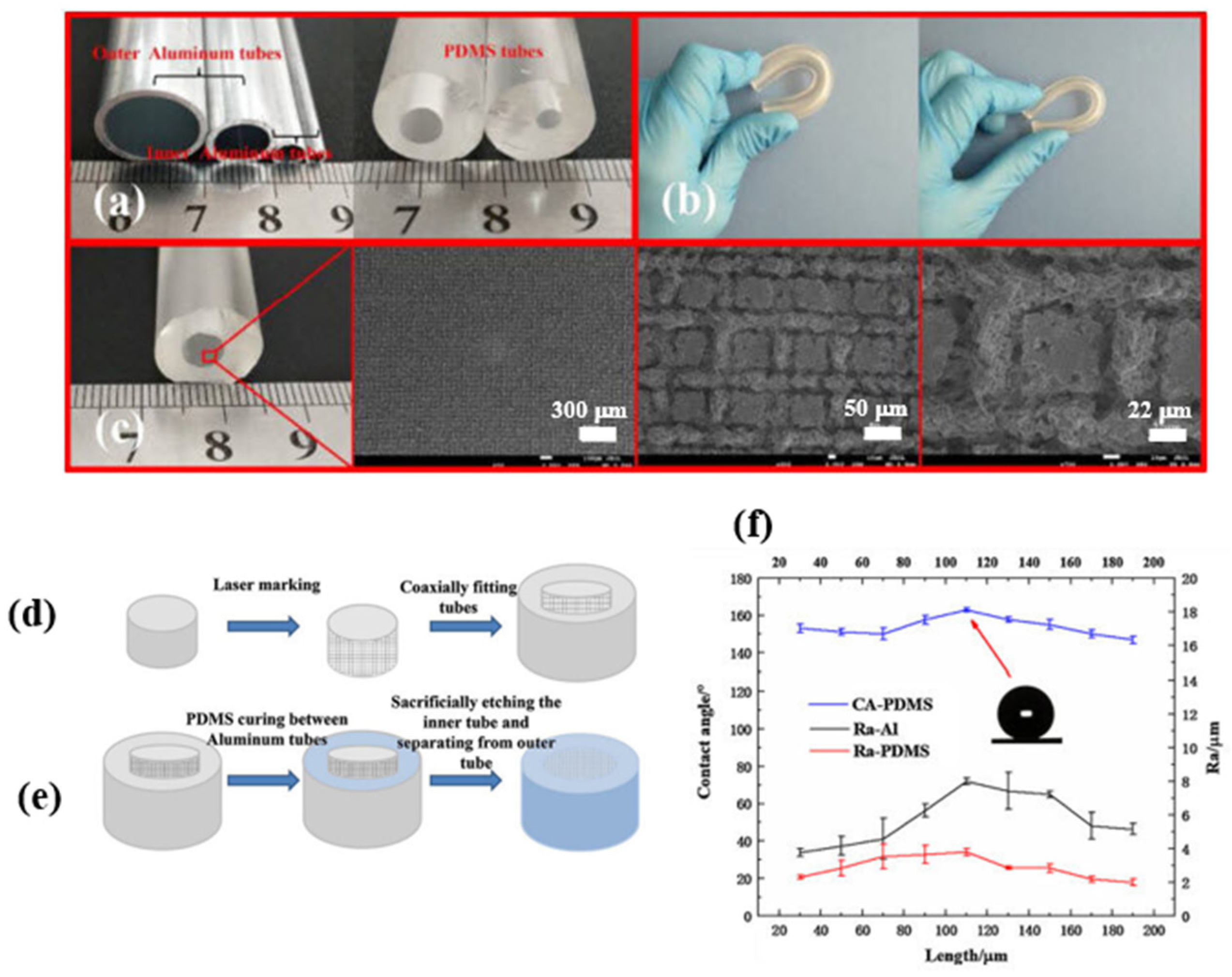
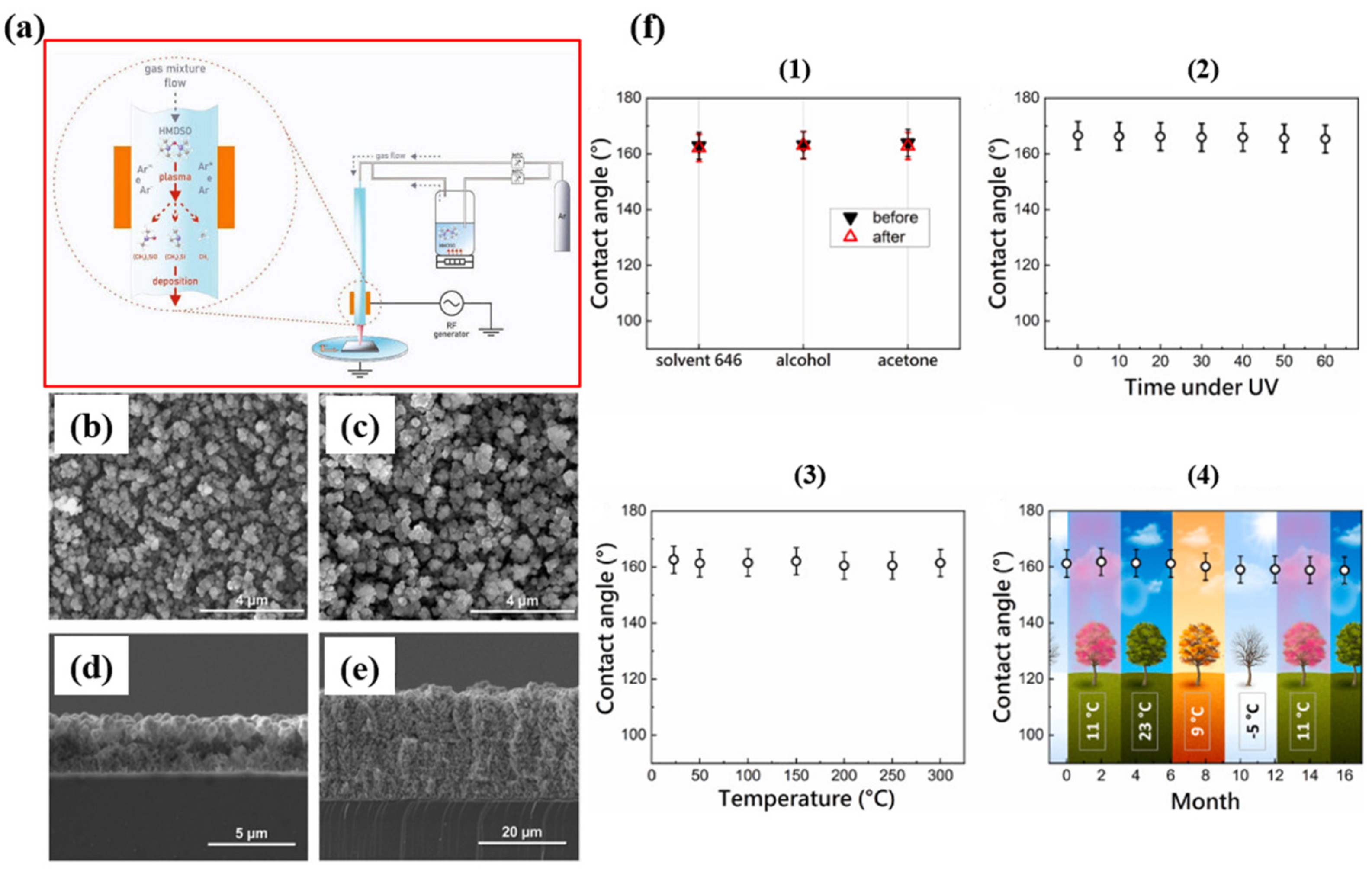



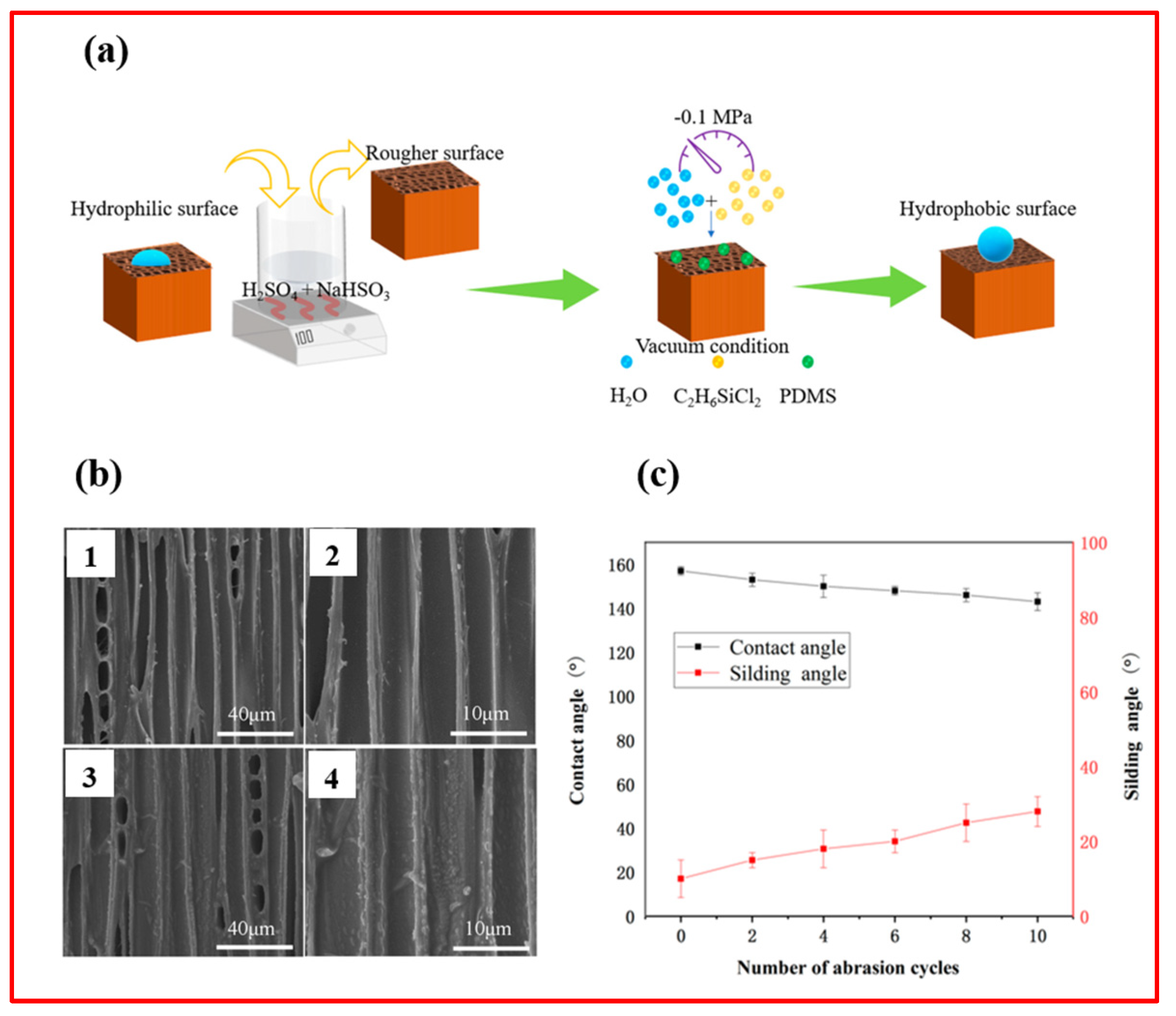

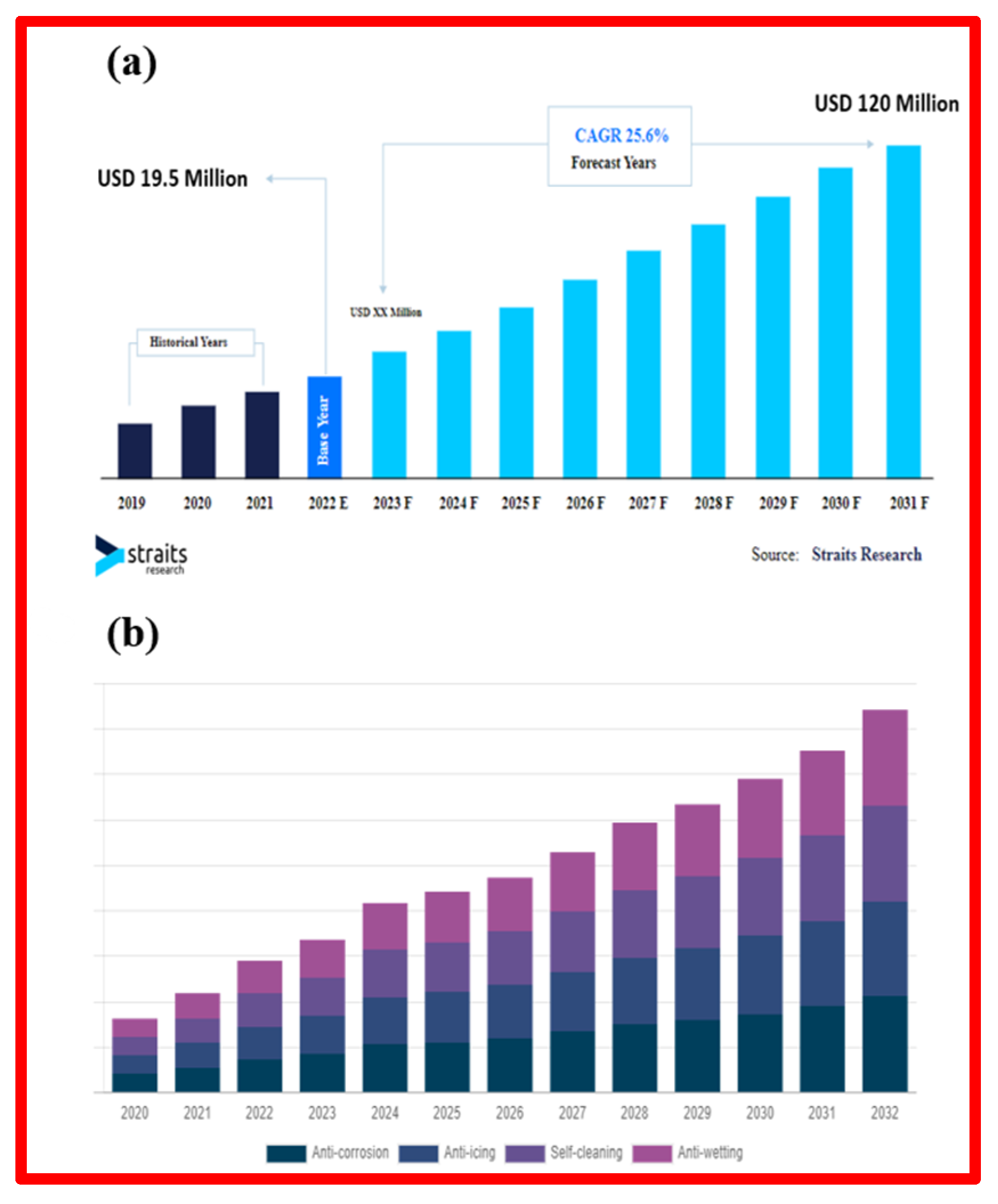
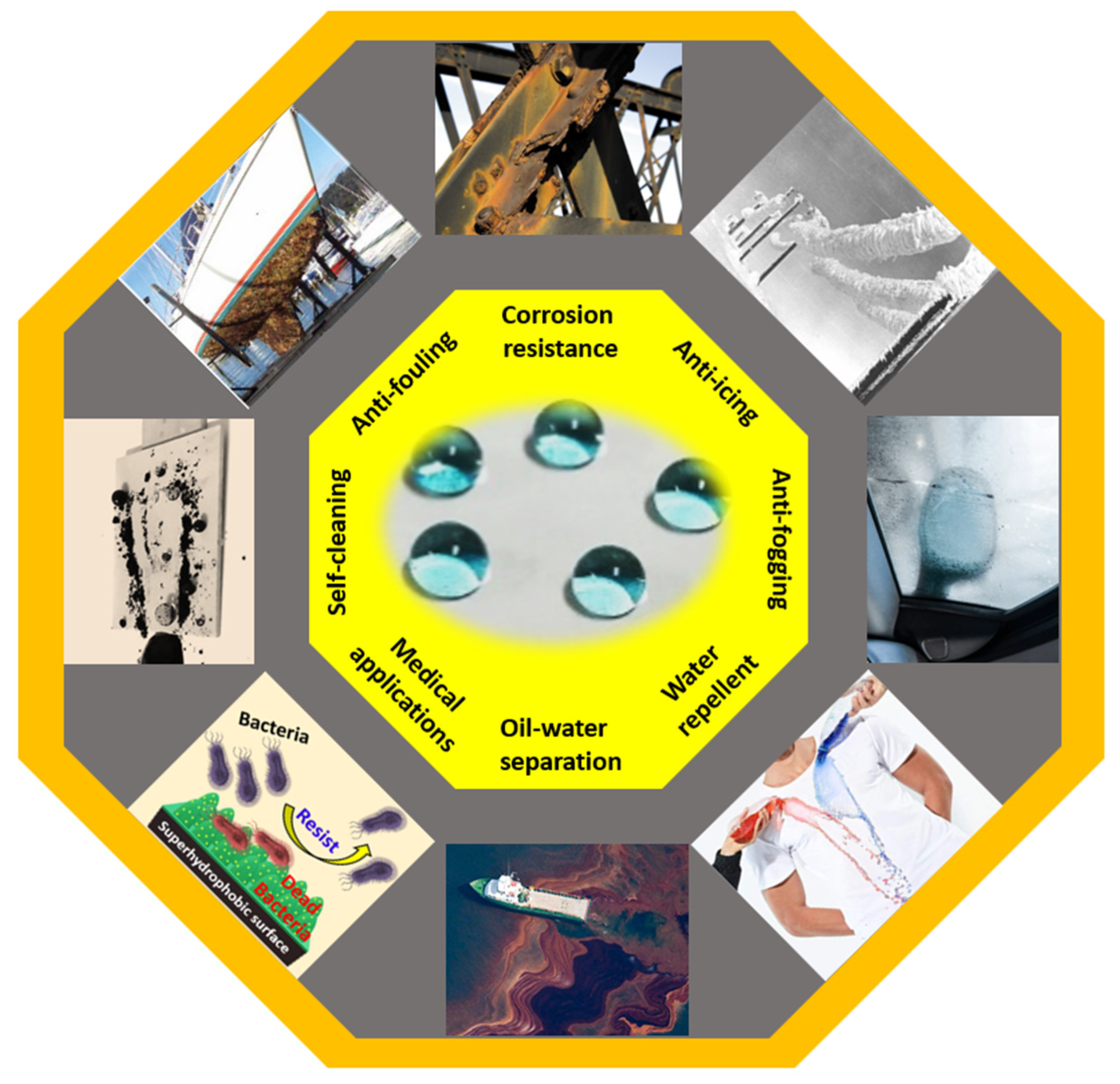

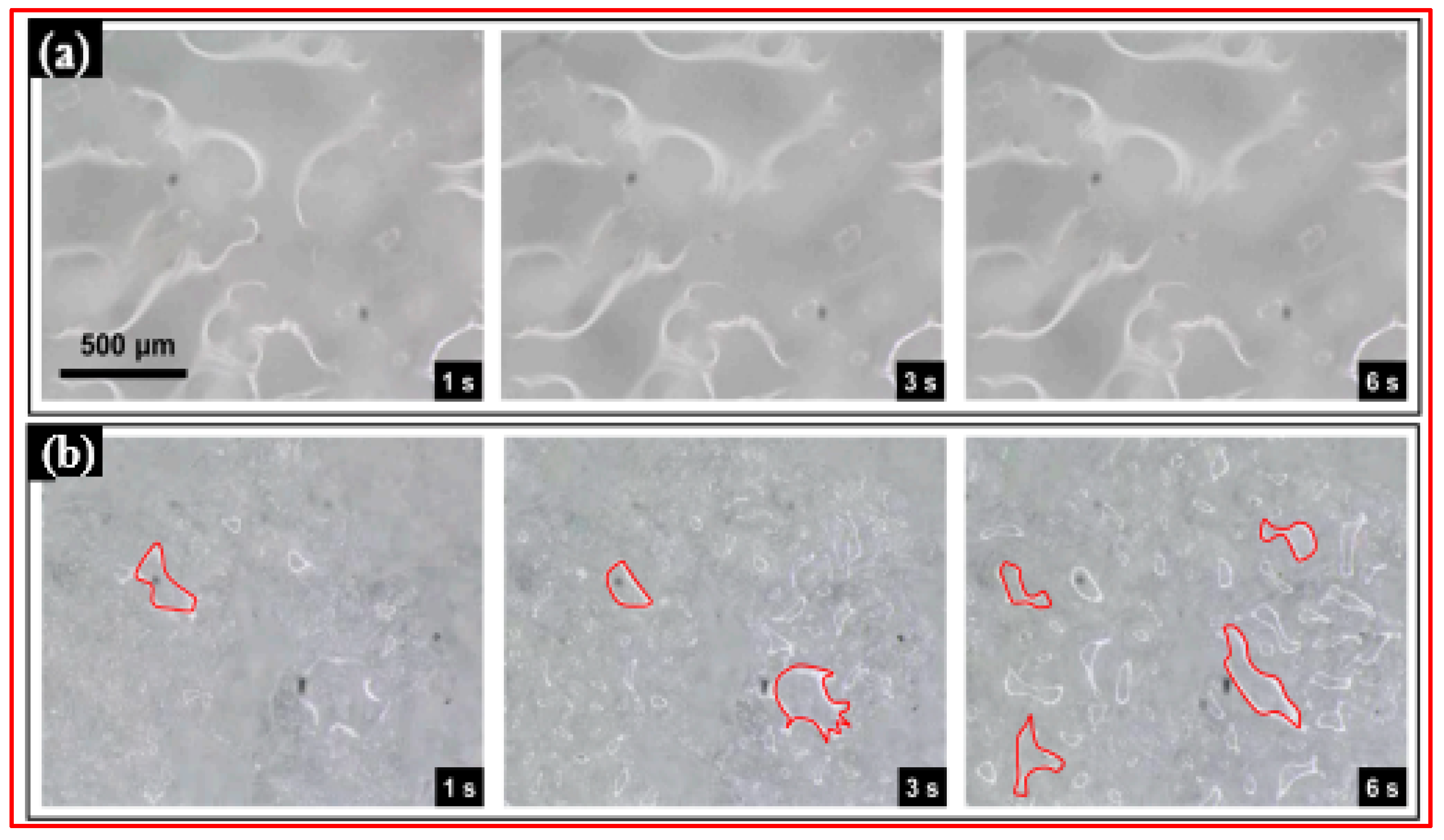
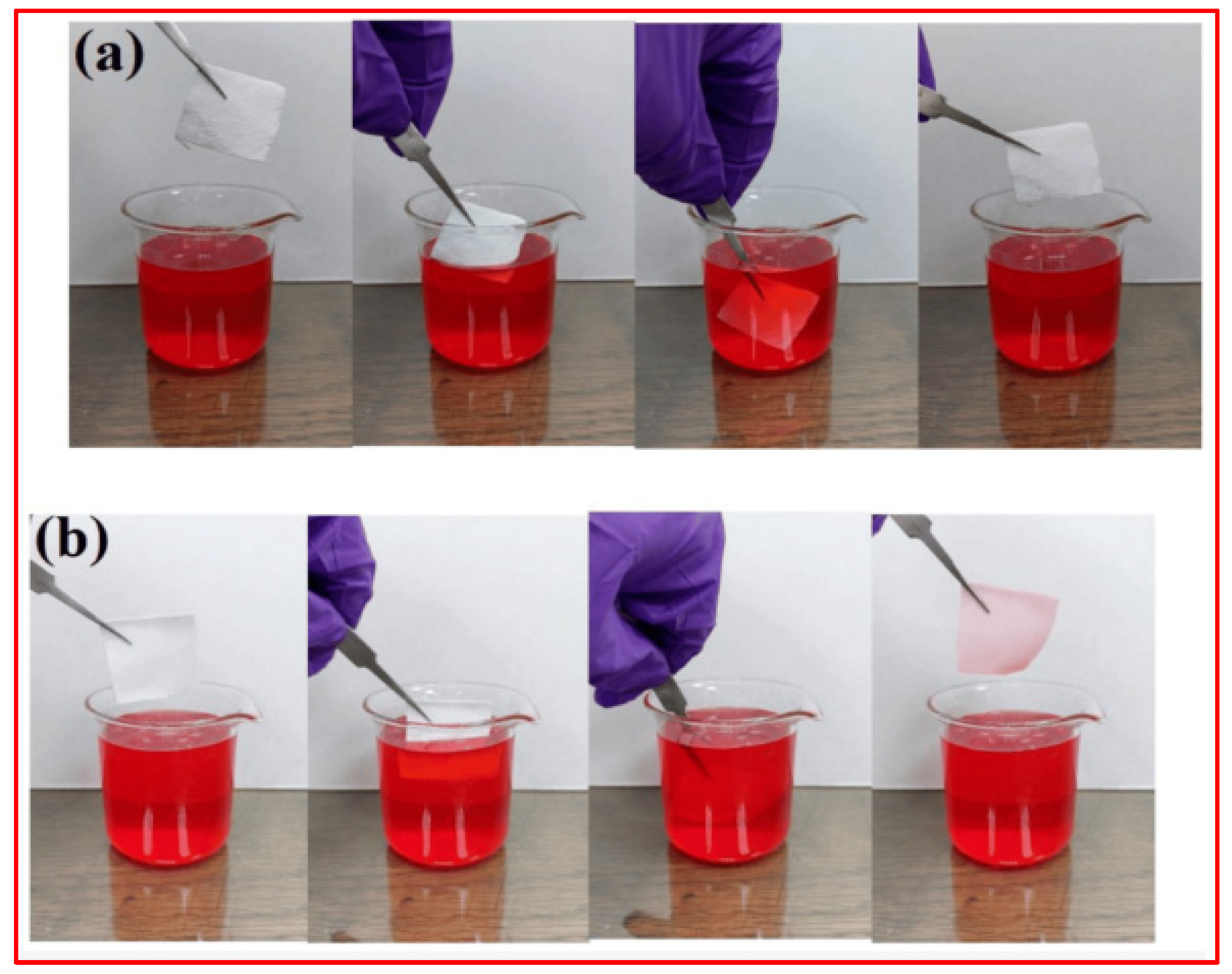
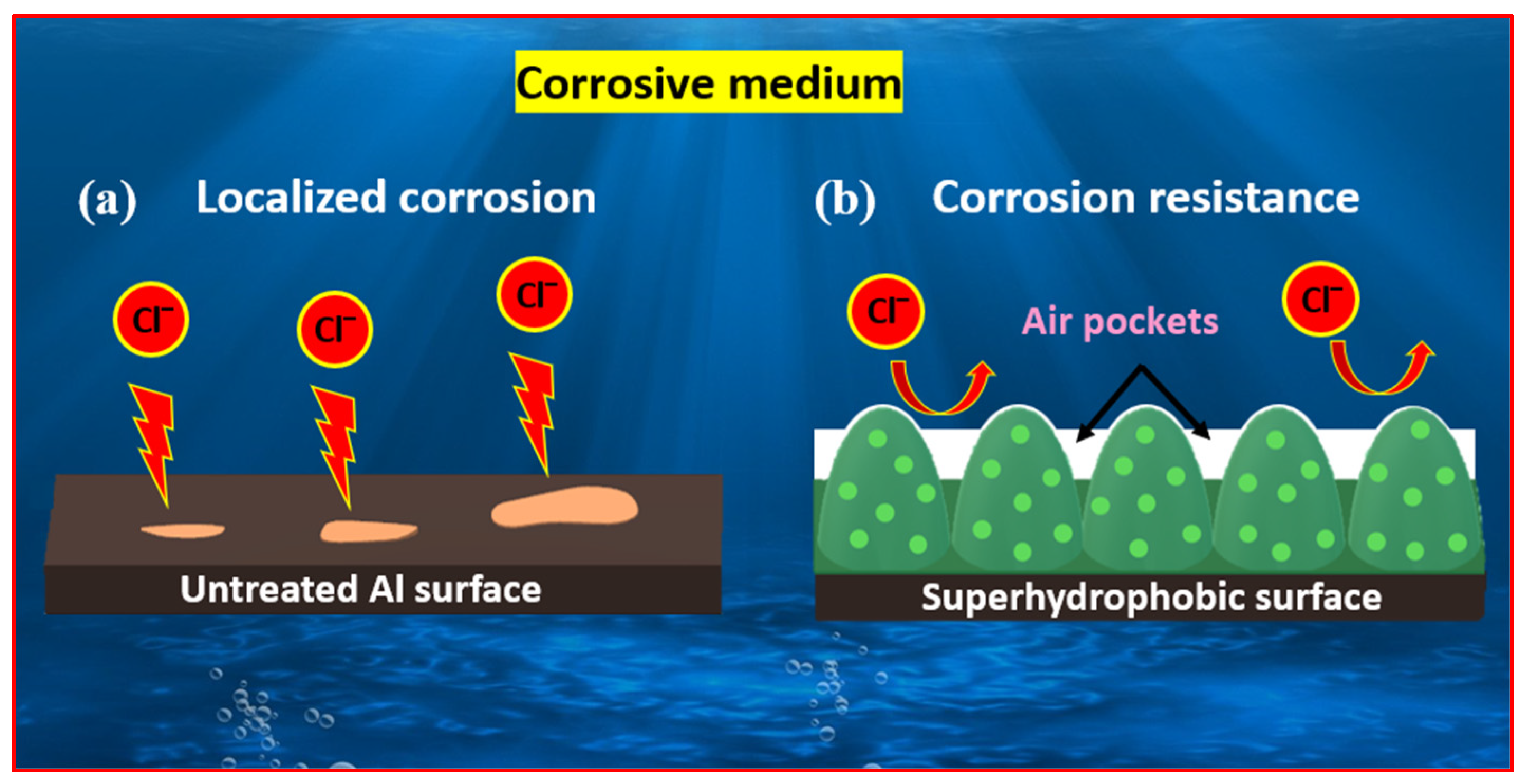
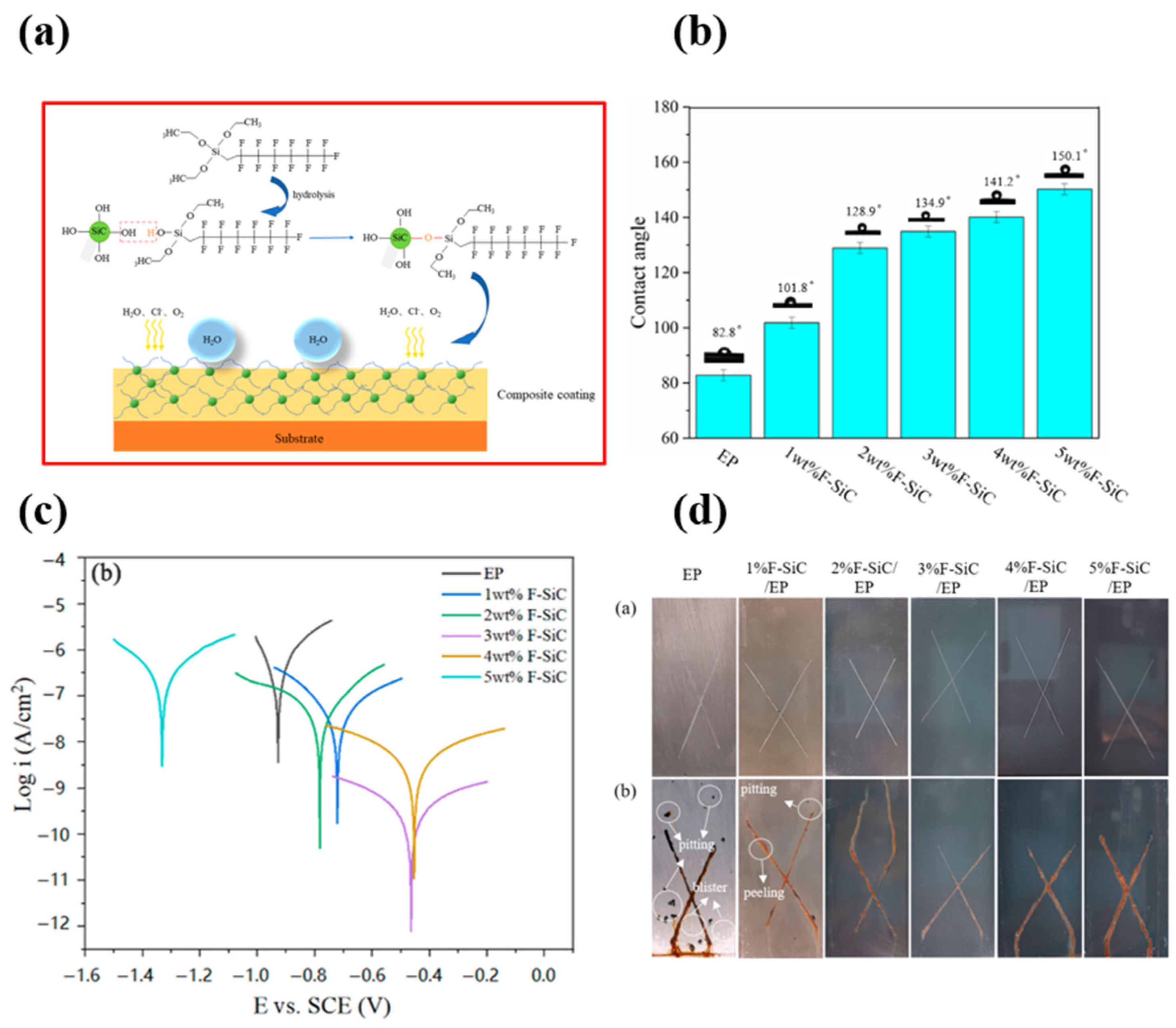

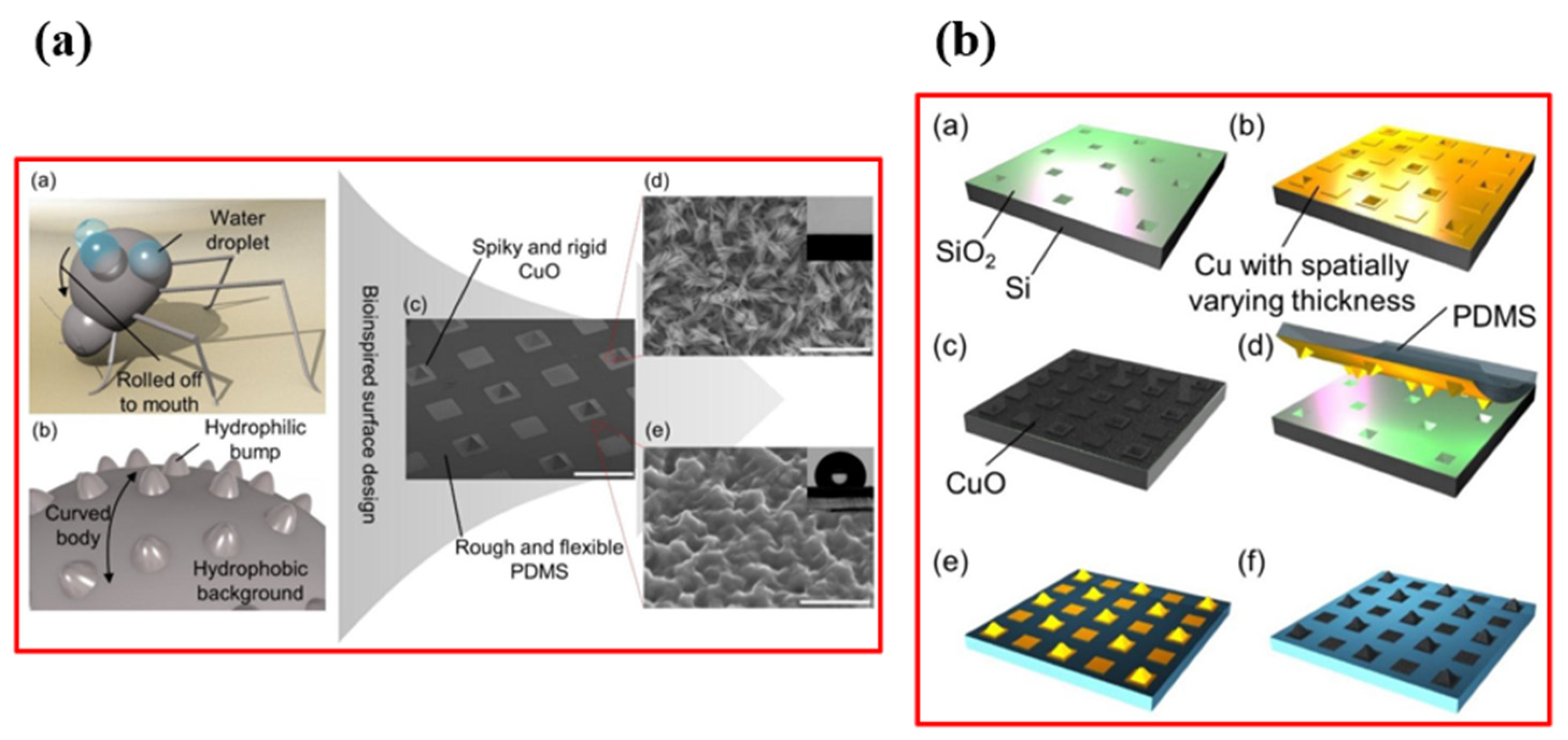
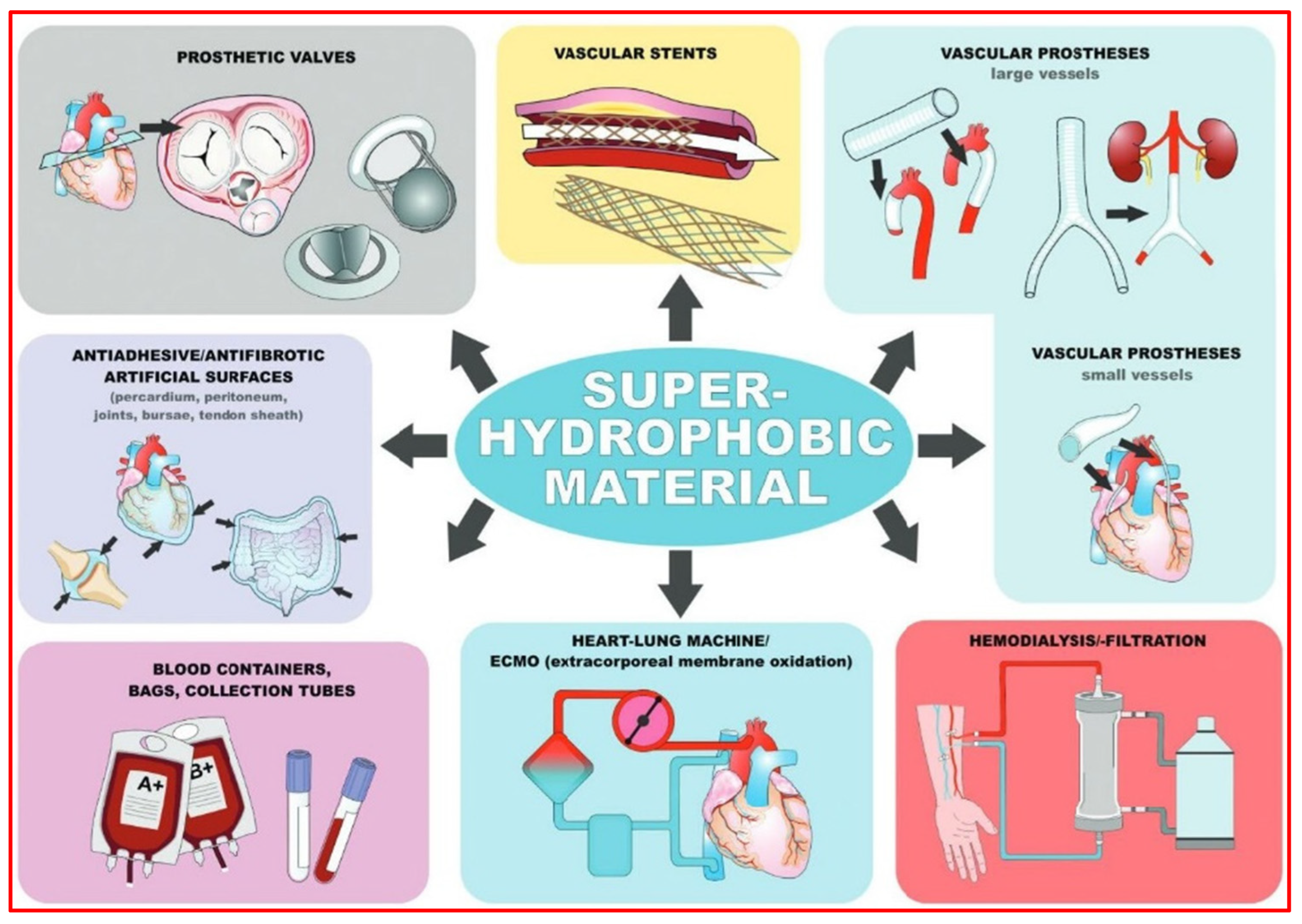

| Natural Surface | WCA | Properties | References |
|---|---|---|---|
| Rice leaf | 164° | Superhydrophobic, self-cleaning, antifouling, and low drag | Bixler et al. (2014) [14] |
| Mosquito compound eyes | 155° | Superhydrophobic and anti-fog | Gao et al. (2007) [16] |
| Butterfly wings | 152 ± 1.7° | Superhydrophobic and self-cleaning | Zheng et al. (2007) [17] |
| Gecko foot | 150° | Superhydrophobic and anti-adhesion | Stark et al. (2016) [19] |
| Water strider legs | 167.6 ± 4.4° | Superhydrophobic and anti-adhesion | Gao et al. (2004) [20] |
| Lotus leaf | >150° | Superhydrophobic and self-cleaning | Barthlott et al. (1997) [24] |
| Indian cress | 180° | Superhydrophobic and self-cleaning | Otten et al. (2004) [25] |
| Shark skin | 160° | Superhydrophobic, self-cleaning, and anti-fouling | Liu et al. (2012) [26] |
| Desert beetle | >150° | Superhydrophobic and fog-collection behavior | Kostal et al. (2018) [27] |
| Rose petal | 154.6° | Superhydrophobic and high surface adhesion | Feng et al. (2008) [28] |
| S. No. | Title | Journal | Publication Date | Features | Ref. |
|---|---|---|---|---|---|
| 1 | Recent advances in superhydrophobic and antibacterial coatings for biomedical Materials | Coatings | October 2022 | Summarized development trends in medical device coatings, focusing on superhydrophobic and antimicrobial coatings. Addressed potential applications and challenges in the commercial adoption of antimicrobial coatings. | Wang et al. [29] |
| 2 | 3D-printed biomimetic structures for energy and environmental applications | DeCarbon | March 2024 | An overview of the current state of 3D-printed biomimetic structures and their applications in energy and environment. | Li et al. [30] |
| 3 | Recent progress on transparent and self-cleaning surfaces by superhydrophobic coatings deposition to optimize the cleaning process of solar panels | Solar Energy Materials and Solar Cells | August 2023 | An overview of the latest studies on self-cleaning superhydrophobic coatings for solar energy applications. | Nomeir et al. [31] |
| 4 | Bioinspired marine antifouling coatings: antifouling mechanisms, design strategies and application feasibility studies | European Polymer Journal | May 2023 | Summarization of the design strategy and development trend of bionic marine antifouling coatings, evaluates the antifouling performance, antifouling mechanism, and antifouling effect of the coatings. | Li et al. [32] |
| 5 | Recent advances in bioinspired sustainable sensing technologies | Nano-Structures & Nano-Objects | April 2023 | A comprehensive overview concerning the innovative approach for identifying, recognizing and showcasing the current advancements and key milestones accomplished in biosensing technologies based on bioinspired/bioderived materials. | Mishra et al. [33] |
| 6 | Recent advances in bio-inspired multifunctional coatings for corrosion protection | Progress in Organic Coatings | July 2022 | An overview of research findings on bioinspired organic/inorganic superhydrophobic and slippery coatings for the corrosion protection of metal substrates. | George et al. [34] |
| 7 | Icephobic/anti-icing properties of superhydrophobic surfaces | Advances in Colloid and Interface Science | June 2022 | The research progress of superhydrophobic materials on icephobictiy in recent years is reviewed from the aspects of ice formation and propagation. | Huang et al. [35] |
| 8 | Bioinspired and green synthesis of nanoparticles from plant extracts with antiviral and antimicrobial properties: A critical review | Journal of Saudi Chemical Society | September 2021 | The advancement in green synthesis of nanoparticles using natural compounds such as plant extracts, fruit juices, and other relevant sources have been highlighted. A deep insight into antiviral and antimicrobial activities of these nanoparticles provided. | Naikoo et al. [36] |
| 9 | Superhydrophobic and superoleophilic membranes for oil–water separation application: A comprehensive review | Materials & Design | June 2021 | A comprehensive review of the SHSO membranes, fabrication and characterization methods, the advantages and disadvantages of the fabrication techniques, current status and prospects of SHSO surfaces, and potential future research directions. | Rasouli et al. [37] |
| 10 | Bioinspired materials for water-harvesting: focusing on microstructure designs and the improvement of sustainability | Materials Advances | November 2020 | Comprehensive insights into the bioinspired water-harvesting materials, focusing on the microstructure designs and improvements of sustainability | Zhang et al. [38] |
| 11 | Bioinspired polymers for lubrication and wear resistance | Progress in Polymer Science | November 2020 | Bioinspired lubrication using novel polymeric structures, which has led to producing a myriad of new systems with effective and sustainable antifriction and wear resistant properties. | Adibnia et al. [39] |
| 12 | Nature-inspired nano-coating materials: drawing inspiration from nature for enhanced functionality | Micromachines | 2024 | Comprehensive overview of the current state of superhydrophobic research. This review aims to guide future investigations and inspire innovations in the development and utilization of these fascinating surfaces. | Present work |
| Fabrication Method | Principle | Advantages | Disadvantages |
|---|---|---|---|
| Chemical etching | Dissolution of surface layers using etchant solutions |
|
|
| Lithography | Involves the transfer of a pattern from a mask to a substrate using light, radiation, or other forms of energy |
|
|
| Template | Using templates to create structured surfaces |
|
|
| Plasma | Alteration of surface properties using plasma |
|
|
| Sol–gel | Condensation polymerizationreactions under colloidal liquidsystems |
|
|
| Hydrothermal | Dissolution; recrystallisation processes at high temperature and pressure |
|
|
| Electrospinning | Droplet spraying and stretching in electric field |
|
|
| Chemical vapor deposition | Vapor-phase deposition of precursor chemicals |
|
|
| Electrochemical deposition | Deposition of material through electrochemical reaction |
|
|
| Layer-by-layer | Inter-particle electrostatic interaction |
|
|
| Fabrication Technique | Coating Material | Substrate | Findings | Reference |
|---|---|---|---|---|
| Modification with HDTMS | Zn-MOF | Cotton fabric | The fabric coating exhibited a WCA of 160° with a hysteresis of 7°, showcasing stable superhydrophobic and self-cleaning characteristics. | [158] |
| Solvothermal and chemical modification method | Nano zinc sulfide (ZnS) | Zinc | Superhydrophobic ZnS coating has excellent chemical and physical self-cleaning properties. | [159] |
| Atmospheric pressure plasma polymerization | Hexamethyldisiloxane (HMDSO) | Glass | The thin films on a glass exhibit outstanding superhydrophobic and self-cleaning properties, featuring a WCA of 165° and an SA of about 2°. | [160] |
| One-step sol. immersion process in Mn (II) aqueous solution and post-modification by stearic acid | Manganese dioxide (MnO2) microspheres | Mg alloy | Fabricated superhydrophobic magnesium alloy exhibits remarkable self-cleaning properties in both oil and air. | [161] |
| Dip coating method | Titanium dioxide nanomaterial | Glass | Fabricated superhydrophobic glass shows an excellent potential for self-cleaning action against contaminants. | [162] |
| Fabrication Technique | Coating Material | Substrate | Findings | Ref. |
|---|---|---|---|---|
| Laser ablation, followed by modification with HDTMS | Hexadecyltrimethoxysilane (HDTMS) | 45 steel |
| [168] |
| Combination of simple chemical etching and anodization, along with modification with poly(dimethylsiloxane) (PDMS) | Silicone oil-infused PDMS (SOIP) coating | Aluminum (Al) |
| [169] |
| Simple spraying and curing process | Nanosilica co-modified with fluoroalkyl silane and aminosilane | Polyurethane |
| [170] |
| Chemical etching and anodization, later modified with PDMS via thermal vapor deposition. | PDMS | Aluminum |
| [171] |
| Crystal growth method | Hollow micro-/nano-structured ZnO (HMN) | Silicon |
| [172] |
| Fabrication Technique | Coating Material | Substrate | Findings | Ref. |
|---|---|---|---|---|
| Modification with HDTMS | Zn-MOF | Cotton fabric | Superhydrophobic surface showed exceptional efficiency of 93, 95, 97, 98%, and 100% in separating engine oil, crude oil, n-hexane, chloroform from water, and viscose oils (sunflower and coconut), and 90% for stabilized emulsion. | [158] |
| Three simple processes: (1) synthesis of MOF-5 nanoparticles; (2) modification using PFOTS; and (3) dip-coating method | Zinc-based metal–organic frameworks (MOF-5) | Sponge | Continuous separation of a variety of oil–organic solvent–water mixtures with a separation efficiency >98%. | [201] |
| Plasma polymerization | Hexamethyldisiloxane (HMDSO) | Fabric and offset printing paper | Superhydrophobic coating has an excellent separation efficiency with the oil contact angle (OCA) of about 0° under the optimal working conditions. | [160] |
| Combining chemical etching and hydrothermal processes | PDMS | Aluminum | Superhydrophobic/superoleophilic mesh shows high separation efficiency (94%) and outstanding reusability. | [202] |
| Dip-coating method | MWCNTs/ZnO composite | Copper mesh | Superhydrophobic and superoleophilic mesh exhibits remarkable reusability and excellent separation efficiency of over 95% for various oils. | [203] |
| Fabrication Technique | Coating Material | Substrate | Findings | Ref. |
|---|---|---|---|---|
| Pulse laser ablation, followed by modification with HDTMS | Hexadecyltrimethoxysilane (HDTMS) | 45 steel | Surface shows superior corrosion resistance compared to steel, with 73.81 times higher charge transfer resistance and 64.78 times lower corrosion current density. | [168] |
| Combination of chemical etching with hydrothermal process, followed by PDMS coating via a simple vapor deposition method | Polydimethylsiloxane (PDMS) | Aluminum alloy | Corrosion resistance of bare surface is significantly enhanced by a magnitude of three after becoming superhydrophobic surface. | [211] |
| Hydrothermal method, with modification by sodium laurate (SL) and sodium dodecylbenzene sulfonate (SDBS). | MgAl-LDH laminates | AZ31 alloy | In a 3.5 wt.% NaCl solution, functional coatings demonstrated remarkable anti-corrosion performance. | [212] |
| Sandblasting and acid treatment, followed by electrodeposition and hydrophobic modification. | Ni-W-TiO2 coating | Steel | Superhydrophobic composite coating can attain a corrosion inhibition rate of 99.63% in 3.5% NaCl solution and at 25 °C. | [213] |
| Eco-friendly green method | Lauric acid | Concrete | Superhydrophobic concrete (WCA > 153° and WSA < 10°) has better corrosion resistance to internal rebars than ordinary concrete. | [214] |
Disclaimer/Publisher’s Note: The statements, opinions and data contained in all publications are solely those of the individual author(s) and contributor(s) and not of MDPI and/or the editor(s). MDPI and/or the editor(s) disclaim responsibility for any injury to people or property resulting from any ideas, methods, instructions or products referred to in the content. |
© 2024 by the authors. Licensee MDPI, Basel, Switzerland. This article is an open access article distributed under the terms and conditions of the Creative Commons Attribution (CC BY) license (https://creativecommons.org/licenses/by/4.0/).
Share and Cite
Barthwal, S.; Uniyal, S.; Barthwal, S. Nature-Inspired Superhydrophobic Coating Materials: Drawing Inspiration from Nature for Enhanced Functionality. Micromachines 2024, 15, 391. https://doi.org/10.3390/mi15030391
Barthwal S, Uniyal S, Barthwal S. Nature-Inspired Superhydrophobic Coating Materials: Drawing Inspiration from Nature for Enhanced Functionality. Micromachines. 2024; 15(3):391. https://doi.org/10.3390/mi15030391
Chicago/Turabian StyleBarthwal, Subodh, Surbhi Uniyal, and Sumit Barthwal. 2024. "Nature-Inspired Superhydrophobic Coating Materials: Drawing Inspiration from Nature for Enhanced Functionality" Micromachines 15, no. 3: 391. https://doi.org/10.3390/mi15030391
APA StyleBarthwal, S., Uniyal, S., & Barthwal, S. (2024). Nature-Inspired Superhydrophobic Coating Materials: Drawing Inspiration from Nature for Enhanced Functionality. Micromachines, 15(3), 391. https://doi.org/10.3390/mi15030391






